Ireland is known for its rich history and cultural heritage; a significant part of this legacy lies in its castles. From ancient ruins to restored fortresses, these architectural marvels serve as a window into the past, allowing visitors to explore Ireland’s history and its unique architectural styles and periods. In this essay, we will delve into the importance of castles in Irish history and culture, discuss the various architectural styles and periods, and provide an overview of the top 47 castles worth visiting in the country. It’s hard to say which one is the best because each one has its own special features and history. Let’s take a look at 47 amazing Irish castles and enjoy what makes each one unique.
Overview of the Top Irish Castles List
Here is a list of the 47 best castles in Ireland you should visit, spanning a range of architectural styles and historical periods. Whether you’re interested in Irish castle history, looking for Irish castles to stay in, Irish castles for weddings, or simply wanting to experience the beauty of these structures, these castles offer something for everyone:
- Dublin Castle (Dublin)
- The Rock of Cashel (Tipperary)
- Kylemore Abbey (Galway)
- Blarney Castle (Cork)
- Trim Castle (Meath)
- King John’s Castle (Limerick)
- Cahir Castle (Tipperary)
- Carrickfergus Castle (Antrim)
- Bunratty Castle (Clare)
- Ashford Castle (Mayo)
- Malahide Castle (Dublin)
- Belfast Castle (Antrim)
- Dunluce Castle (Antrim)
- Ross Castle (Kerry)
- Leap Castle (Offaly)
- Lismore Castle (Waterford)
- Athlone Castle (Westmeath)
- Enniscorthy Castle (Wexford)
- Donegal Castle (Donegal)
- Glenveagh Castle (Donegal)
- Slane Castle (Meath)
- Birr Castle (Offaly)
- Dunguaire Castle (Galway)
- Rock of Dunamase (Laois)
- Classiebawn Castle (Sligo)
- Knappogue Castle (Clare)
- Doe Castle (Donegal)
- Dunlough Castle (Cork)
- McDermott’s Castle (Roscommon)
- Clough Oughter Castle (Cavan)
- Adare Castle (Limerick)
- Minard Castle (Kerry)
- Doonagore Castle (Clare)
- Kinbane Castle (Antrim)
- Blackrock Castle (Cork)
- Kilkenny Castle (Kilkenny)
- Lough Eske Castle (Donegal)
- Glin Castle (Limerick)
- Dromoland Castle (Clare)
- Ballynahinch Castle (Galway)
- Bective Abbey (Meath)
- Ballysaggartmore Towers (Waterford)
- Castle Leslie (Monaghan)
- Kilkishen Castle (Clare)
- Ballinalacken Castle (Clare)
- Aughnanure Castle (Galway)
- Castle Ward (Down)
1. Dublin Castle (Dublin)
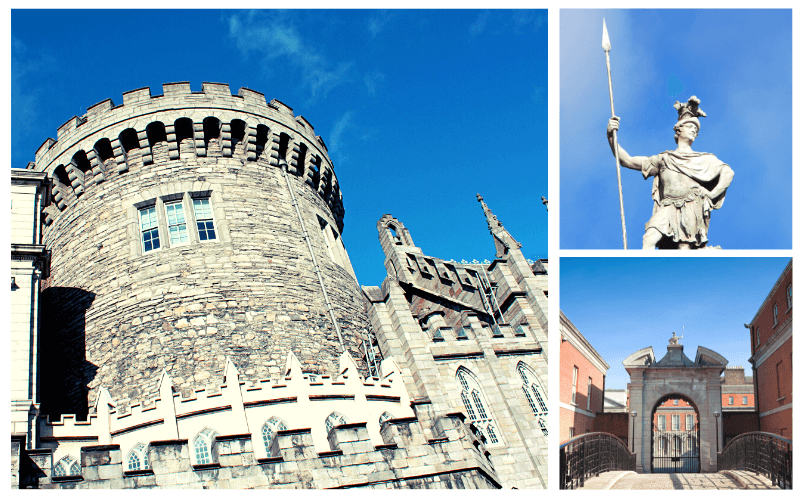
History: Dublin Castle, located in the heart of the Irish capital, has played a significant role in the country’s history since its construction in the early 13th century. The castle was built on the orders of King John of England as a major defensive structure and center of administration. For centuries, it served as the seat of English and later British rule in Ireland, until it was handed over to the newly formed Irish government in 1922 following the establishment of the Irish Free State.
Features: The castle complex features a mix of architectural styles, reflecting the various stages of its long history. Some of the most notable structures include the medieval Record Tower, the 18th-century State Apartments, the Chapel Royal, and the modern Conference Centre. The State Apartments, once the residence of the British viceroy, now serve as the venue for prestigious state events and ceremonies. The well-preserved Dubh Linn Gardens, situated on the site of the original Viking settlement, provide a tranquil green space within the castle grounds.
Legends: One popular legend surrounding Dublin Castle is the story of the Black Pool, or “Dubh Linn” in Irish, which gave the city its name. It is said that the pool was once inhabited by a fearsome serpent, which was eventually slain by Saint Patrick, the patron saint of Ireland. This tale reflects the rich mythological heritage of Ireland and the enduring influence of Saint Patrick in the country’s history and culture.
Significance: Dublin Castle holds immense historical, political, and cultural significance for Ireland. As the former seat of British rule, it played a central role in the country’s tumultuous past, including the 1916 Easter Rising and the subsequent War of Independence. Today, it serves as a symbol of Irish sovereignty and is a major tourist attraction, offering visitors a unique insight into the nation’s history and heritage. The castle’s architecture and the Dubh Linn Gardens also make it a noteworthy destination for those interested in art and landscape design.
Check out this highly-rated Dublin Castle guided tour.
2. The Rock of Cashel (Tipperary)
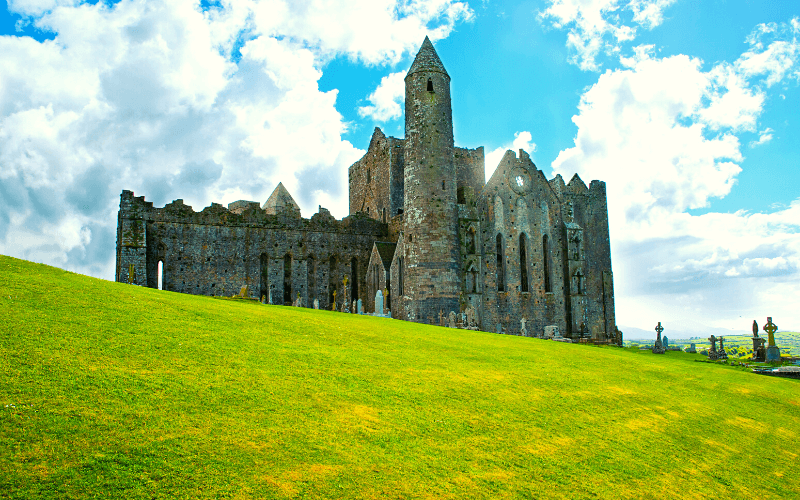
History: The Rock of Cashel, also known as St. Patrick’s Rock, is a historic site located in County Tipperary, Ireland. The site has been associated with various Irish kings and royalty since the 4th century, including the powerful Eóganachta dynasty. The Rock became an important religious center in the 12th century when King Muircheartach Ua Briain donated it to the Church. Throughout its history, the Rock of Cashel experienced numerous events, including the infamous sacking by the Cromwellian forces in 1647.
Features: The Rock of Cashel comprises several impressive medieval structures, including the iconic Round Tower, the Cormac’s Chapel, the Cathedral, and the Hall of the Vicars Choral. The Round Tower, dating back to the early 12th century, stands at approximately 28 meters tall and is a prime example of traditional Irish architecture. Cormac’s Chapel, built in the Romanesque style, is particularly famous for its rare frescoes and stone carvings. The Cathedral, constructed between the 13th and 15th centuries, features an impressive Gothic design and a stunning view of the surrounding countryside.
Legends: A popular legend associated with the Rock of Cashel involves Saint Patrick, the patron saint of Ireland. It is said that during his visit to the Rock, Saint Patrick banished all the snakes from Ireland by driving them into the sea. This legend, although likely symbolic rather than literal, has become a central part of the Irish national identity and Saint Patrick’s Day celebrations.
Significance: The Rock of Cashel holds great historical and religious significance for Ireland. It represents a crucial period in the country’s history when the power dynamics between the secular and religious authorities were changing. As one of the most remarkable collections of Celtic art and medieval architecture in Europe, the Rock of Cashel is a must-see destination for anyone interested in Irish history, art, and religion. In addition, the site’s legends and connection to Saint Patrick make it an important part of Ireland’s rich cultural heritage.
3. Kylemore Abbey (Galway)
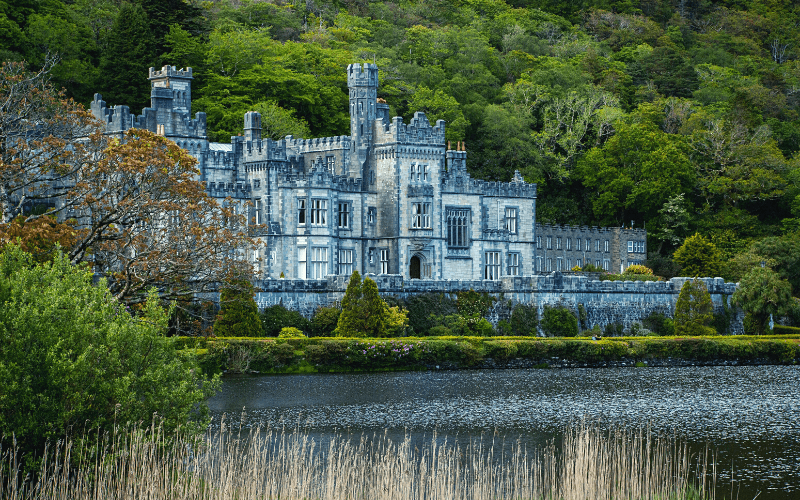
History: Kylemore Abbey, situated in the heart of Connemara in County Galway, Ireland, was originally built as a private residence for the wealthy English businessman Mitchell Henry and his wife Margaret. Construction began in 1867 and was completed in 1871, creating a stunning example of Victorian architecture in a remote and picturesque setting. The estate was sold to the Duke and Duchess of Manchester in 1903, but financial difficulties forced them to sell it again in 1920. The Benedictine nuns, who had fled Belgium during World War I, purchased the property and established a boarding school and a convent. While the school closed in 2010, the nuns continue to reside at Kylemore Abbey, maintaining it as a place of worship and retreat.
Features: Kylemore Abbey is a stunning example of Victorian neo-Gothic architecture, with its majestic façade and intricate detailing. The estate encompasses 1,000 acres, including a six-acre Victorian Walled Garden, which is home to beautifully restored garden buildings, formal flower gardens, and a kitchen garden. Visitors can also explore the neo-Gothic Church, built as a memorial to Margaret Henry, and a Mausoleum where Mitchell and Margaret Henry are buried. The surrounding landscape of Connemara provides a breathtaking backdrop for the estate, with the Twelve Bens mountain range and the Pollacapall Lough nearby.
Legends: Kylemore Abbey is said to be haunted by the ghost of Margaret Henry, who died tragically during a family holiday in Egypt in 1874. Her heartbroken husband, Mitchell Henry, built the neo-Gothic Church in her memory, and her spirit is said to linger within the castle walls and surrounding grounds.
Significance: Kylemore Abbey is a symbol of love, dedication, and resilience. The Henry family’s devotion to each other and their estate, the Benedictine nuns’ commitment to their faith and community, and the beautiful landscape all contribute to the Abbey’s lasting allure. Today, Kylemore Abbey is a popular tourist destination, offering visitors a glimpse into the lives of the Henry family, the Benedictine community, and the stunning beauty of the Connemara region.
Guided Tour: The Kylemore Abbey Full-Day Guided Tour offers visitors an immersive experience of the history, architecture, and natural beauty of the estate and its surroundings. With knowledgeable guides leading the way, participants will explore the stunning interiors of the Abbey, learn about its rich history, and hear the fascinating stories of the people who lived and worked there.
4. Blarney Castle (Cork)
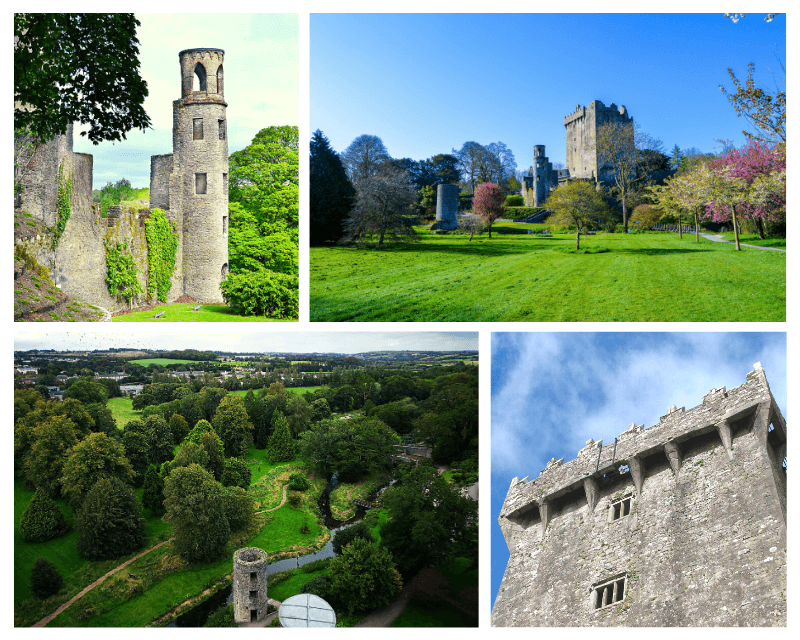
History: Blarney Castle, located near Cork, Ireland, is a medieval fortress that dates back to the early 13th century. Originally built by the McCarthy clan, the castle has a rich and varied history, having been besieged, destroyed, and rebuilt multiple times. Cormac MacCarthy, the King of Munster, constructed the current castle in the mid-15th century. Throughout its existence, Blarney Castle has been a symbol of Irish resistance against English rule and has passed through the hands of several influential families.
Features: Blarney Castle is a prime example of a medieval fortress, with its imposing battlements, towering keep, and fortified walls. The castle is surrounded by lush gardens, including the famous Poison Garden, which houses a collection of toxic and dangerous plants. However, the castle’s most famous feature is the Blarney Stone, a block of limestone built into the battlements. According to legend, anyone who kisses the stone while hanging upside-down will be granted the gift of eloquence.
Legends: The Blarney Stone is the center of numerous legends and stories. One tale claims that an old woman cast a spell on the stone to reward a king who had saved her from drowning. The king then kissed the stone, and the spell granted him the ability to speak with great charm and persuasiveness. Another story suggests that the stone was brought to Ireland from Scotland during the Crusades and that it originally belonged to the biblical prophet Jeremiah.
Significance: Blarney Castle holds a unique place in Irish history and culture, thanks to the legend of the Blarney Stone. Kissing the stone has become a popular tradition for visitors from around the world, turning the castle into a must-see attraction in Ireland. Additionally, Blarney Castle serves as a testament to Ireland’s rich architectural and historical heritage, providing a fascinating glimpse into the country’s tumultuous past.
5. Trim Castle (Meath)
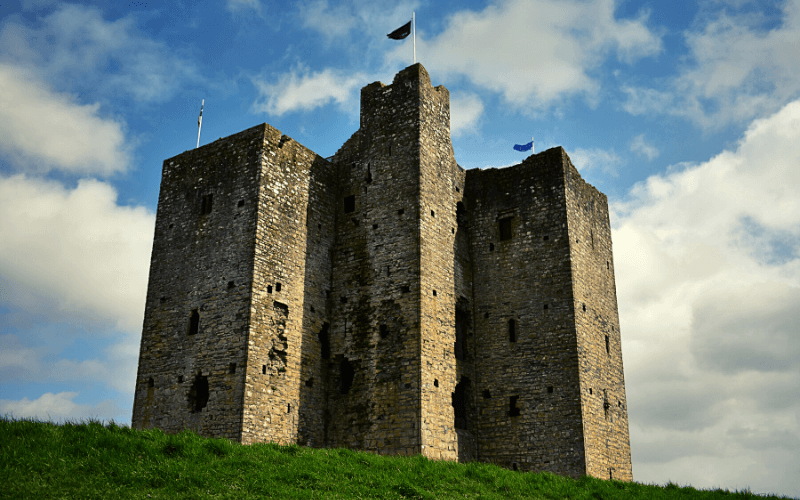
History: Trim Castle, situated in County Meath, Ireland, is an impressive Norman fortress dating back to the late 12th century. Constructed by Hugh de Lacy, a Norman knight who was granted the lands by King Henry II of England, the castle was designed to secure the newly acquired territory and assert control over the local population. Over the centuries, Trim Castle has witnessed numerous battles, sieges, and changes of ownership, and it has played a crucial role in Irish history.
Features: Trim Castle is the largest Anglo-Norman castle in Ireland, covering an area of over 30,000 square meters. The castle’s central keep stands three stories high and is surrounded by a curtain wall, which contains several towers and a fortified gatehouse. The castle’s design is characterized by its unique cruciform shape, which provided additional defensive capabilities. Visitors can explore the interior of the keep, the curtain walls, and the surrounding grounds, which offer stunning views of the River Boyne.
Legends: While there are no specific legends associated with Trim Castle, the fortress has a storied past that has inspired tales of bravery, treachery, and intrigue. The castle has changed hands many times throughout history, serving as the backdrop for power struggles, political maneuverings, and military campaigns. The castle’s imposing presence has fueled the imagination of countless generations, contributing to its enduring allure.
Significance: Trim Castle is an important historical site in Ireland, showcasing the architectural prowess and military strategy of the Norman invaders. The castle’s remarkable preservation allows visitors to experience a tangible connection to Ireland’s past and gain a deeper understanding of the country’s complex history. In addition, the castle’s cinematic appearance has made it a popular filming location, most notably for the 1995 movie “Braveheart.”
6. King John’s Castle (Limerick)
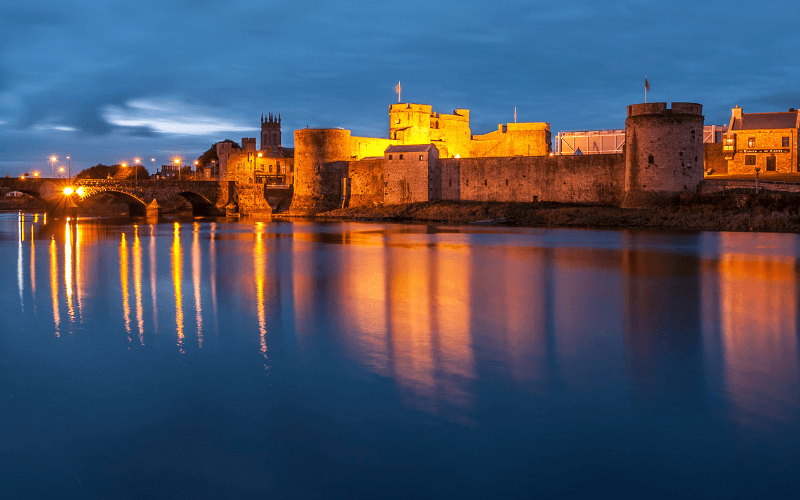
History: King John’s Castle, located in Limerick City, Ireland, is a formidable 13th-century fortress built by the order of King John of England. Construction began in 1200 under the supervision of Bishop Geoffrey de Marisco, who was tasked with strengthening the city’s defenses and establishing Limerick as a prominent administrative center. Over the years, the castle has played a key role in various conflicts, including the Irish Confederate Wars, the Williamite War, and the Irish Civil War.
Features: King John’s Castle boasts a massive curtain wall punctuated by five large drum towers, offering a prime example of Norman military architecture. The castle’s riverside location on the banks of the River Shannon provided a strategic advantage, while its thick walls and imposing gatehouse offered additional protection. Today, visitors can explore the castle’s towers, ramparts, and courtyard, as well as a modern interactive exhibition that provides an immersive experience of the site’s history.
Legends: While no specific legends surround King John’s Castle, it has been the center of many significant historical events and tales. One of the most dramatic episodes in the castle’s history occurred in 1642 when it was besieged by an Irish Confederate force. Despite being heavily outnumbered, the castle’s defenders managed to hold out for several months until they were finally relieved by a Royalist army.
Significance: King John’s Castle is a testament to the power and influence of the English crown in medieval Ireland. As one of the best-preserved examples of Norman architecture in the country, it offers valuable insights into the engineering techniques and military strategies of the time. The castle serves as a powerful symbol of Limerick’s turbulent history and provides an engaging educational experience for visitors interested in Ireland’s past.
7. Cahir Castle (Tipperary)
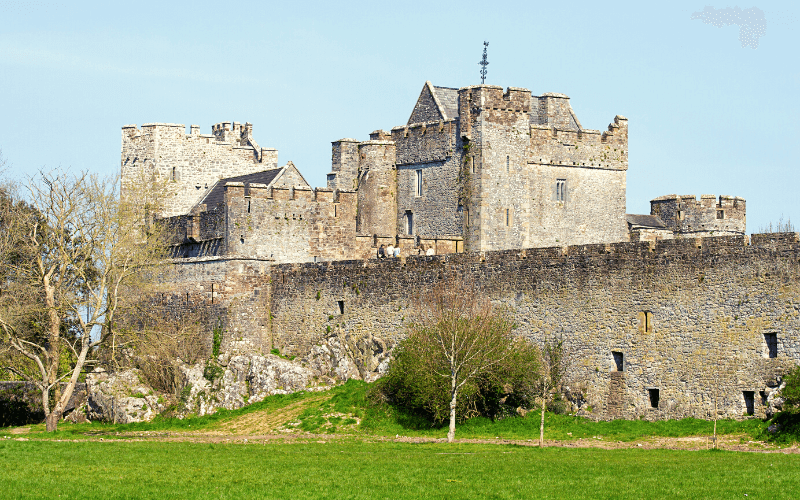
History: Cahir Castle, one of Ireland’s largest and best-preserved castles, is situated on an island in the River Suir in County Tipperary. The castle was originally built in the 13th century by the powerful O’Brien family, who were granted the land by King John of England. In the late 14th century, the castle was taken over by the Butler family, who made several additions and improvements over the years. Cahir Castle has witnessed several sieges throughout its history, including those during the Irish Confederate Wars and the Cromwellian Conquest of Ireland.
Features: Cahir Castle showcases a remarkable blend of architectural styles, from the original 13th-century keep to the later expansions in the 15th and 16th centuries. The castle is characterized by its impressive curtain walls, massive towers, and an inner ward that encloses a courtyard. Visitors can explore the various chambers, halls, and staircases within the castle, as well as the well-preserved portcullis and drawbridge.
Legends: While no specific legends are associated with Cahir Castle, its rich history has given rise to several tales and stories. One such story involves the Earl of Essex, who laid siege to the castle in 1599 during the Nine Years’ War. According to the tale, the castle’s defenders were caught off guard when they mistook the approaching English army for a herd of deer, allowing the Earl’s forces to capture the castle with ease.
Significance: Cahir Castle is a striking example of medieval Irish fortress architecture and stands as a testament to the power and wealth of the O’Brien and Butler families. The castle’s history reflects the shifting allegiances and political landscape of Ireland over the centuries, making it an important site for understanding the nation’s past. Today, Cahir Castle is a popular tourist attraction and an essential stop for anyone interested in Ireland’s medieval history.
8. Carrickfergus Castle (Antrim)
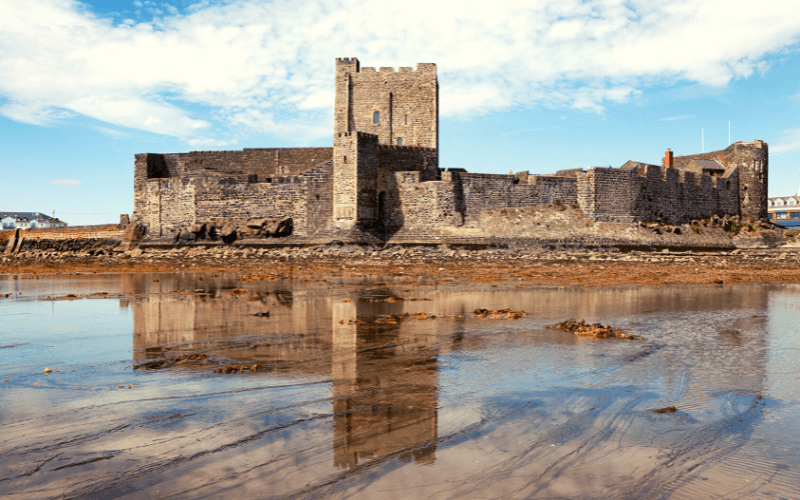
History: Carrickfergus Castle, located in the coastal town of Carrickfergus in County Antrim, Northern Ireland, dates back to the 12th century. Sir John de Courcy, an Anglo-Norman knight, built the castle as his main stronghold after conquering the area in 1177. The castle has played a crucial role in various conflicts throughout its history, including the Anglo-Norman invasion of Ireland, the Nine Years’ War, and the Williamite War. It has also served as a garrison and a prison, and remained in military use until 1928.
Features: Carrickfergus Castle is a prime example of Norman military architecture in Ireland. Its massive keep, polygonal curtain walls, and imposing gatehouse are the most prominent features. The castle also has a well-preserved great hall and living quarters, where visitors can gain insight into the daily life of its inhabitants. The castle stands on a rocky outcrop overlooking the harbor, which allowed it to control the approach by sea.
Legends: One of the most famous legends associated with Carrickfergus Castle is the story of Button Cap, a ghostly figure said to haunt the castle’s tower. The spirit is believed to be that of a soldier who was executed for attempting to take over the castle by force. His restless soul is said to wander the castle, especially around the tower where he met his end.
Significance: Carrickfergus Castle is an essential landmark in the history of Ireland and Northern Ireland, providing insight into the region’s turbulent past. As one of the best-preserved Norman castles in the country, it offers a unique window into medieval military architecture and life. Today, the castle is a popular tourist attraction, with guided tours and exhibits that bring its history to life for visitors.
9. Bunratty Castle (Clare)
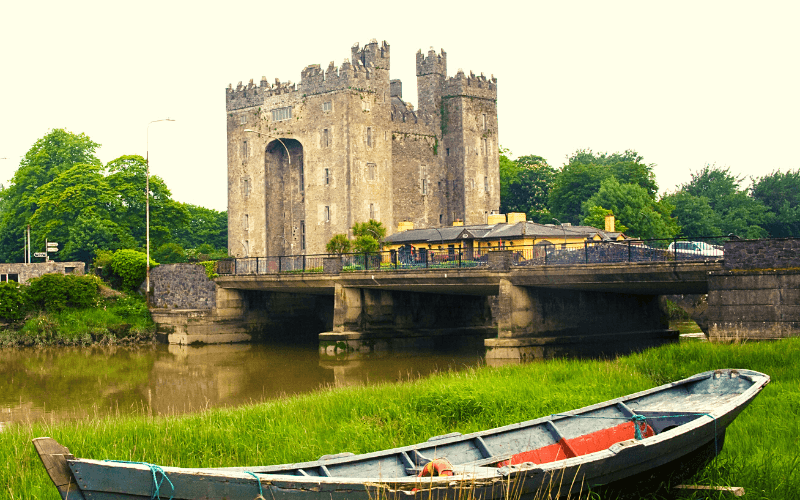
History: Bunratty Castle, situated in the village of Bunratty in County Clare, Ireland, has a history that dates back to the early 13th century. The current structure is the fourth castle to be built on the site and was constructed by the MacNamara family around 1425. In 1543, the castle was granted to the O’Brien family, who were the Earls of Thomond, and they held it until the 18th century. The castle fell into disrepair for a period, but it was purchased and meticulously restored by Lord Gort in the 20th century.
Features: Bunratty Castle is a prime example of a medieval fortress, featuring a central keep surrounded by defensive walls and corner towers. The keep boasts four floors, including a great hall, living quarters, and private chambers. The castle is furnished with period artifacts and tapestries, giving visitors a glimpse into the lives of its medieval inhabitants. The grounds of the castle also include a 19th-century folk park, which recreates a traditional Irish village and offers an immersive experience of rural life in the past.
Legends: One of the most popular legends associated with Bunratty Castle is the story of the “Bunratty Banshee.” According to the tale, the banshee is the spirit of a woman who died tragically in the castle, and her mournful wails can be heard on certain nights. Some versions of the legend claim that the banshee only appears to members of the O’Brien family, warning them of impending doom.
Significance: Bunratty Castle is a significant historical site in Ireland, offering an authentic look into medieval life and architecture. The castle’s restoration and the addition of the folk park have made it a popular tourist attraction, where visitors can explore the castle, attend medieval banquets, and experience the living history of Ireland. The castle also hosts various events throughout the year, including traditional Irish music sessions and cultural festivals, making it a vibrant cultural hub in County Clare.
10. Ashford Castle (Mayo)
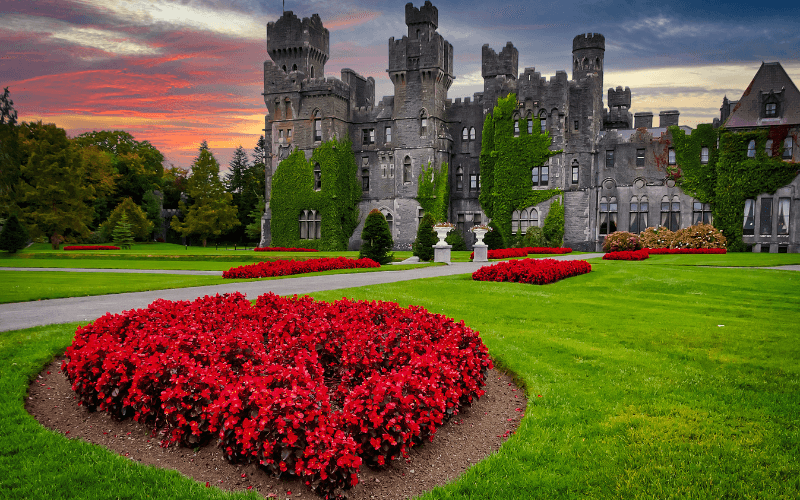
History: Ashford Castle, located in County Mayo, was first built in the 13th century by the Anglo-Norman de Burgo family. Over the centuries, the castle has been expanded and modified by various owners, including the Guinness family, who purchased it in the 19th century. In the 20th century, the castle was transformed into a luxurious hotel, which has welcomed many famous guests, including royalty, politicians, and celebrities.
Features: Ashford Castle boasts an impressive range of architectural styles, reflecting its long and varied history. The castle has undergone extensive renovations and expansions, resulting in a blend of medieval, Victorian, and Georgian elements. The 350-acre estate surrounding the castle features beautiful gardens, a golf course, and access to the picturesque Lough Corrib.
Legends: One popular legend associated with Ashford Castle is that of the White Horse of Ashford, which is said to roam the estate at night. According to the legend, a beautiful white horse appears on the grounds and, if ridden by a person of pure heart, can grant them a single wish before disappearing.
Significance: Ashford Castle is a significant landmark in Ireland, showcasing the country’s rich architectural history and providing visitors with a luxurious and unique lodging experience. Its beautiful setting, coupled with its legendary tales, adds to the allure of the castle, making it an essential destination for those seeking a taste of Irish history and opulence.
Accommodation: For those looking to experience a luxurious stay steeped in history, Ashford Castle offers exceptional accommodation options. This 5-star hotel provides guests with elegantly appointed rooms and suites, blending traditional charm with modern comforts. Each room is uniquely designed, featuring antique furnishings, sumptuous fabrics, and original artwork. Guests can enjoy a range of world-class amenities, including a spa, fine dining options, and an array of outdoor activities such as golf, fishing, and horseback riding. Staying at Ashford Castle is truly an unforgettable experience that will transport you back in time while indulging in the finest comforts of the present day.
11. Malahide Castle (Dublin)
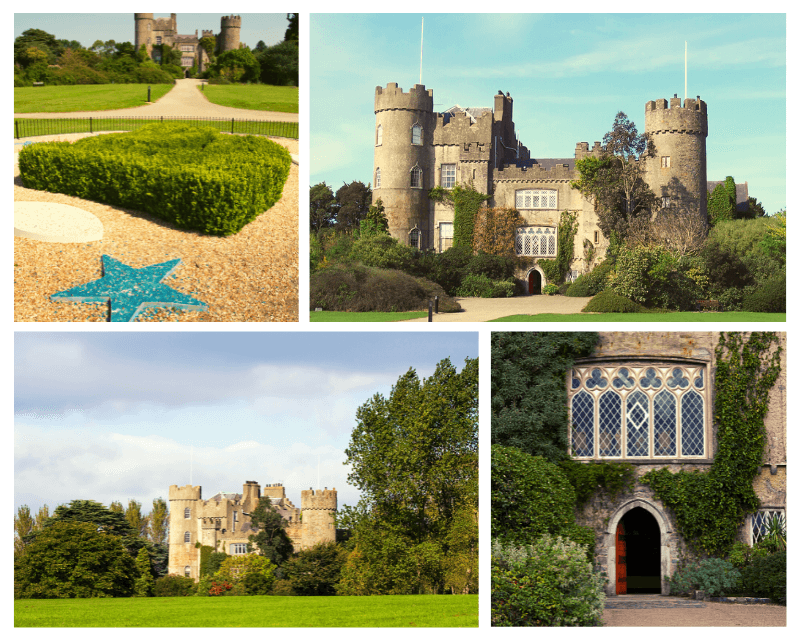
History: Malahide Castle, situated in the charming seaside town of Malahide in County Dublin, was built in the 12th century by Richard Talbot, a loyal knight of King Henry II of England. The Talbot family resided in the castle for nearly 800 years, with the exception of a brief period during the Cromwellian conquest. In 1975, the last Talbot descendant sold the castle to the Irish State, and it has since been open to the public.
Features: Malahide Castle is an architectural gem, with its combination of medieval, Georgian, and Gothic styles. The castle features a Great Hall, intricately carved wooden panels, and lavish reception rooms. The 260-acre park surrounding the castle includes stunning gardens, a butterfly house, and a picturesque walking trail.
Legends: One of the most famous legends surrounding Malahide Castle is that of Puck, the mischievous jester. Puck, who served as a jester and caretaker of the castle, is said to have fallen in love with a prisoner named Lady Elenora Fitzgerald. Tragically, Puck was found dead outside the castle walls, and it is believed that his ghost still haunts the premises, particularly the turret where Lady Elenora was imprisoned.
Significance: Malahide Castle holds a special place in Irish history, as it was home to the Talbot family for centuries and played a role in the country’s turbulent past. Today, the castle serves as a popular tourist attraction and a venue for special events and concerts, offering visitors a chance to experience its rich history, architectural beauty, and enchanting legends.
12. Belfast Castle (Antrim)
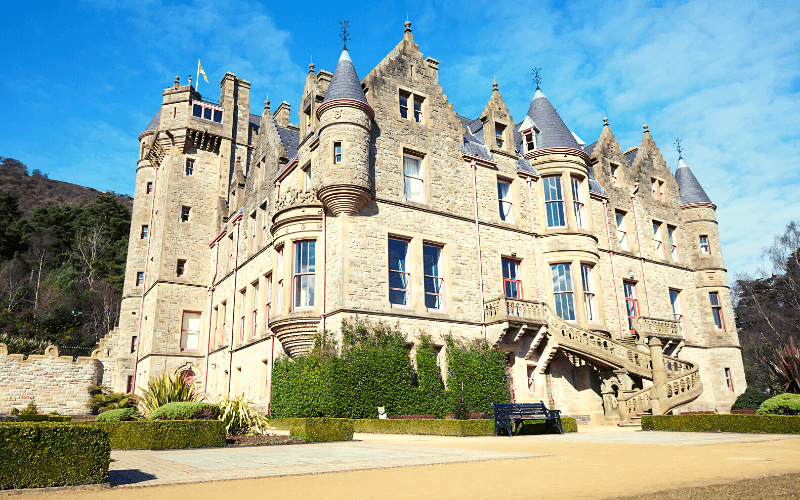
History: Belfast Castle, located on the slopes of Cave Hill in Belfast, Northern Ireland, has a history that dates back to the late 12th century. The original castle was built by the Normans in the city center but was destroyed by a fire in 1708. The current Belfast Castle was constructed between 1862 and 1870 by the Marquess of Donegall and was designed in the Scottish Baronial style. In 1934, the castle and its surrounding estate were gifted to the city of Belfast by the Shaftesbury family, and it has since been a prominent public attraction.
Features: Belfast Castle boasts an impressive architectural design, featuring corner turrets, a central tower, and ornate stonework. The interior of the castle is lavishly decorated with Victorian furnishings and ornamental details. The surrounding estate spans 100 acres and includes beautiful gardens, walking trails, and panoramic views of the city and Belfast Lough. The castle is now a popular venue for weddings, conferences, and other events.
Legends: While Belfast Castle may not have a specific legend tied to it, the surrounding area of Cave Hill has its own intriguing folklore. The hill is said to have inspired Jonathan Swift’s “Gulliver’s Travels” due to the sleeping giant-like profile of the hill’s face. There are also tales of hidden treasure within the caves and secret passageways, although no treasure has ever been discovered.
Significance: Belfast Castle is an important landmark in the city of Belfast, offering a stunning example of Victorian architecture and a glimpse into the city’s history. The castle and its grounds provide a serene escape from the bustling city and serve as a popular destination for locals and tourists alike. The castle’s role as a public venue for events and celebrations further contributes to its significance as a cultural and social hub within Belfast.
13. Dunluce Castle (Antrim)
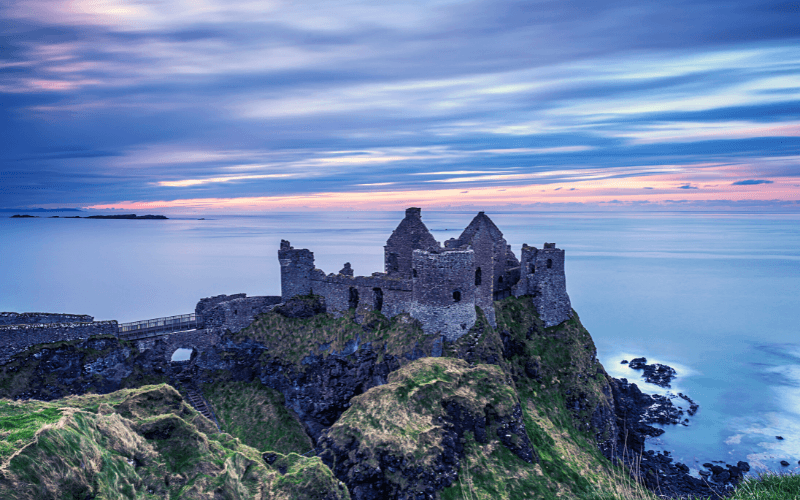
History: Dunluce Castle, perched dramatically on the edge of a basalt cliff overlooking the North Atlantic Ocean in County Antrim, Northern Ireland, has a rich history dating back to the 13th century. The castle was built by the Anglo-Norman Richard de Burgh, the Earl of Ulster, and later became the stronghold of the MacDonnell clan in the 16th century. The castle has witnessed numerous battles and sieges over the centuries and is famously associated with the tragic sinking of the Girona, a Spanish Armada ship, in 1588. The castle was abandoned in the late 17th century after part of the structure collapsed into the sea during a storm.
Features: Dunluce Castle is known for its dramatic location and stunning views of the surrounding coastline. The castle’s ruins include a great hall, a gatehouse, and residential buildings, as well as the remnants of a defensive wall. An archaeological excavation in the early 21st century revealed the remains of a “lost town” just outside the castle walls, believed to have been a thriving merchant settlement in the 17th century.
Legends: There are several legends associated with Dunluce Castle. One popular tale is that of the castle’s kitchens collapsing into the sea during a stormy night, taking with it the kitchen staff and the dinner being prepared for a grand feast. Another legend tells of a banshee haunting the castle, mourning the loss of her child who was killed during a siege.
Significance: Dunluce Castle is a significant historical site, offering a unique window into the tumultuous past of the region. The castle has become an iconic symbol of Northern Ireland’s dramatic landscape and serves as a popular tourist destination. The recent discovery of the “lost town” adds another layer to the castle’s significance, shedding light on the everyday life of the people who lived and worked in the shadow of this imposing fortress.
14. Ross Castle (Kerry)
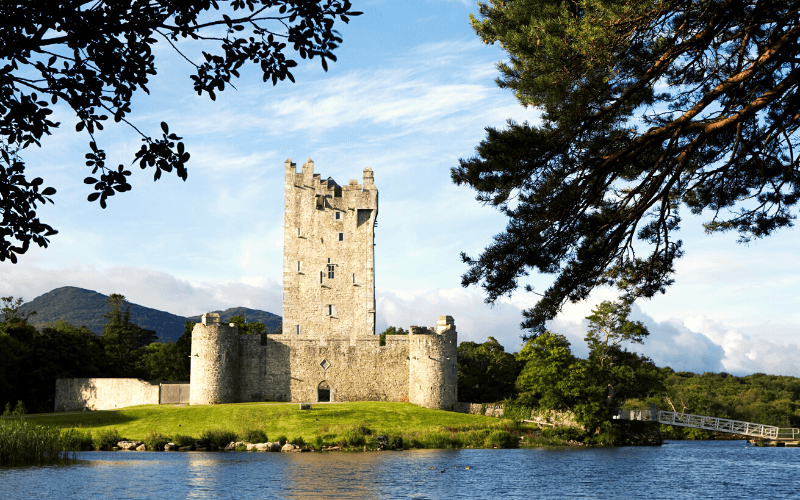
History: Ross Castle, located on the shores of Lough Leane in Killarney National Park, County Kerry, was built in the 15th century by O’Donoghue Mór, the chieftain of the area. The castle served as a stronghold for the O’Donoghue clan until the 17th century, when it was taken over by Cromwellian forces. It was subsequently owned by various families, including the Earls of Kenmare until it was handed over to the Irish State in the 20th century.
Features: Ross Castle is an impressive example of a medieval tower house with a fortified square keep, round towers, and battlements. The castle’s interior is furnished with period pieces, giving visitors a glimpse into the lives of its former residents. The scenic location of the castle, nestled within the lush surroundings of Killarney National Park, adds to its charm and allure.
Legends: One of the most famous legends associated with Ross Castle is that of O’Donoghue Mór himself. It is believed that O’Donoghue still resides deep within the waters of Lough Leane and emerges every seven years on the morning of May 1st to ride around the lake on his white horse. Anyone fortunate enough to catch a glimpse of O’Donoghue during this ride is said to be granted good fortune for the rest of their lives.
Significance: Ross Castle holds historical and cultural significance as a representation of the power struggles that took place during Ireland’s turbulent past. It is a popular tourist attraction, with visitors drawn to its stunning location, rich history, and fascinating legends. The castle also serves as a starting point for boat trips around the picturesque lakes of Killarney National Park, offering visitors a unique way to explore the area’s natural beauty.
15. Leap Castle (Offaly)
History: Leap Castle, located in County Offaly, was built in the late 15th or early 16th century by the O’Carroll clan, who were notorious for their cruelty and ruthlessness. The castle has a dark and violent history, marked by power struggles, murders, and betrayals within the O’Carroll family. It eventually passed into the hands of the Darby family in the 17th century, and later, in the 20th century, it was owned by various private individuals.
Features: Leap Castle is a rectangular tower house with a central keep, square towers, and battlements. The castle’s most infamous feature is the Bloody Chapel, where several gruesome events are said to have occurred, including the murder of a priest by his own brother. The castle has been restored over the years, and its current owner has worked to preserve its historic charm while also making it a welcoming place for visitors.
Legends: Leap Castle is known as one of the most haunted castles in Ireland, with numerous tales of ghostly encounters and paranormal activity. The most famous ghost is the “Elemental,” a malevolent spirit believed to be an ancient presence that predates the castle itself. Other reported apparitions include the “Red Lady,” a mysterious figure holding a dagger, and the ghosts of the murdered O’Carroll clan members.
Significance: The haunting history and legends of Leap Castle make it a unique destination for those interested in Ireland’s darker past. The castle’s eerie atmosphere attracts visitors seeking a thrilling and chilling experience, and it has been featured on numerous television shows and documentaries about the paranormal. The castle also serves as a reminder of the brutal power struggles that once plagued the Irish nobility and the often-cruel nature of life in medieval Ireland.
16. Lismore Castle (Waterford)
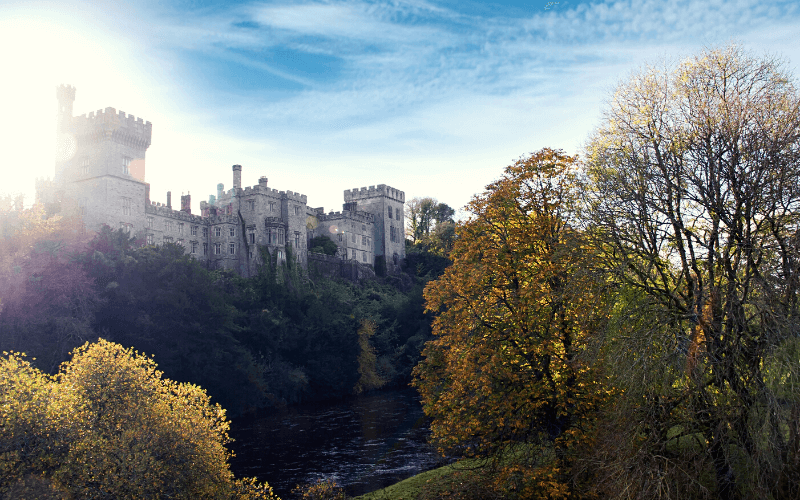
History: Lismore Castle, situated in County Waterford, dates back to the 12th century when it was built by Prince John, who later became King John of England. Over the centuries, it has changed hands multiple times, with notable owners including Sir Walter Raleigh and Richard Boyle, the 1st Earl of Cork. The castle was transformed into a luxurious estate in the 19th century by the 6th Duke of Devonshire, who made extensive renovations and added beautiful gardens to the property.
Features: Lismore Castle is a stunning example of Gothic architecture, with its crenelated towers, pointed arches, and intricate stone carvings. The castles interior boasts elegant rooms, including the magnificent Pugin Banqueting Hall, a library, and several other beautifully furnished spaces. The castle is surrounded by lush gardens, which are split into the Upper and Lower Gardens, featuring a variety of plants, sculptures, and stunning views of the River Blackwater.
Legends: While Lismore Castle is not known for being haunted, it does have a connection to a famous legend. The castle was the home of Robert Boyle, a renowned scientist and philosopher, who is said to have inspired the story of Dr. Faustus. According to the legend, Faustus was a scholar who sold his soul to the devil in exchange for knowledge and power. This tale has been retold in various forms over the centuries, with Christopher Marlowe’s play “Doctor Faustus” being one of the most famous adaptations.
Significance: Lismore Castle holds historical and architectural significance as one of the most beautiful and well-preserved Gothic castles in Ireland. Its connection to notable figures like Sir Walter Raleigh, Richard Boyle, and the Dukes of Devonshire adds to its rich history. The castle’s gardens are also considered some of the finest in Ireland, making it a popular destination for horticulture enthusiasts. Additionally, Lismore Castle’s link to the legend of Dr. Faustus offers a fascinating insight into the literary and cultural history of the area.
17. Athlone Castle (Westmeath)
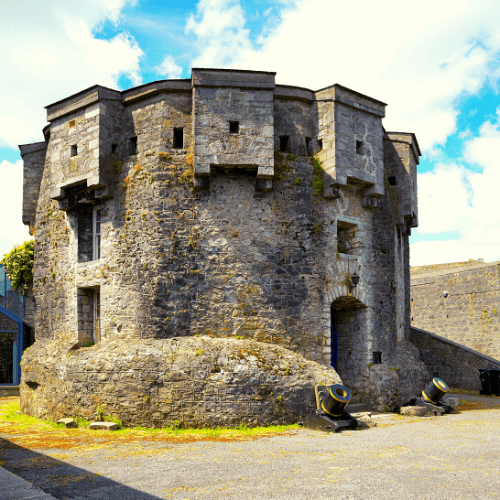
History: Athlone Castle, situated along the banks of the River Shannon in County Westmeath, Ireland, was built in the 13th century by the Anglo-Norman invaders on the orders of King John. The castle served as a strategic stronghold to defend the crossing point of the river and has played a crucial role in Irish history. In 1690, during the Williamite War in Ireland, Athlone Castle was the site of the famous Siege of Athlone, where the Jacobite forces held off the Williamite army for several days before eventually succumbing.
Features: Athlone Castle is a prominent example of a medieval fortress, with imposing stone walls and sturdy defensive towers. The castle’s keep, also known as King John’s Tower, is its most distinctive feature. Over the centuries, the castle has been modified and updated, with additions such as a gun platform and bastions in the 17th century. Today, the castle houses a state-of-the-art visitor center, showcasing the history of Athlone and its people through interactive exhibitions.
Legends: One legend associated with Athlone Castle revolves around the Siege of Athlone in 1690. According to the tale, a brave sergeant named Custume led a small group of Jacobite soldiers to destroy the castle’s main gate, preventing the Williamite forces from crossing the river. This heroic act allowed the Jacobite defenders to hold off the enemy for several more days. Sergeant Custume’s bravery is still remembered today, with a bridge in Athlone named in his honor.
Significance: Athlone Castle is an important historical site in Ireland, showcasing the rich history of the region and the many battles fought to control this strategic location. The castle is not only a reminder of Ireland’s turbulent past but also a testament to the resilience of the Irish people. The castle’s visitor center provides an engaging experience for tourists and locals alike, allowing them to immerse themselves in the history and stories of Athlone and its people.
18. Enniscorthy Castle (Wexford)
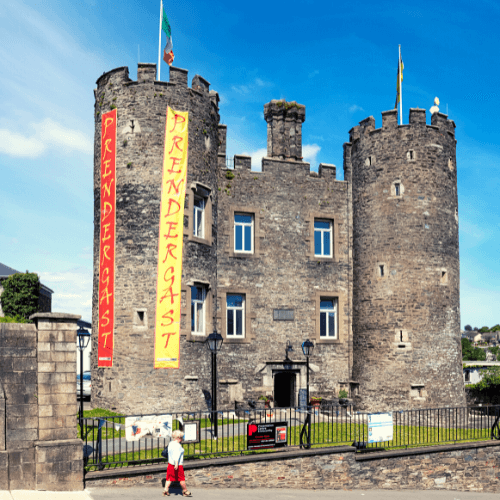
History: Enniscorthy Castle is located in the heart of Enniscorthy, County Wexford, Ireland. It was originally built in the 13th century by the Anglo-Normans and served as a stronghold for the powerful Prendergast family. Throughout its history, the castle changed hands numerous times, including periods under the control of the Irish Confederate forces and the British Crown. In 1798, the castle was a significant site during the Irish Rebellion, when it was occupied by the United Irishmen.
Features: The castle is a classic example of a Norman fortress, with square towers at each corner and a central courtyard. The exterior walls are made of limestone, and the interior features vaulted ceilings and a spiral staircase leading to the rooftop, which offers panoramic views of the town and surrounding countryside. Today, Enniscorthy Castle houses the Wexford County Museum, which showcases local history, art, and archaeology.
Legends: One of the most famous legends surrounding Enniscorthy Castle is the story of the ghostly presence of a young woman named Wilhelmina, who is said to haunt the castle. She was reportedly a member of the Roche family, who owned the castle during the 17th century. According to the legend, Wilhelmina fell in love with a young soldier who was later killed in battle. Heartbroken, she died shortly after, and her spirit is said to wander the castle, still mourning her lost love.
Significance: Enniscorthy Castle is an important historical site in County Wexford, representing the rich and complex history of the region. The castle has played a significant role in Irish history, particularly during the 1798 Rebellion. Today, the castle serves as an important cultural and educational center, housing the Wexford County Museum and providing visitors with an engaging and informative experience of the area’s history, culture, and heritage.
19. Donegal Castle (Donegal)
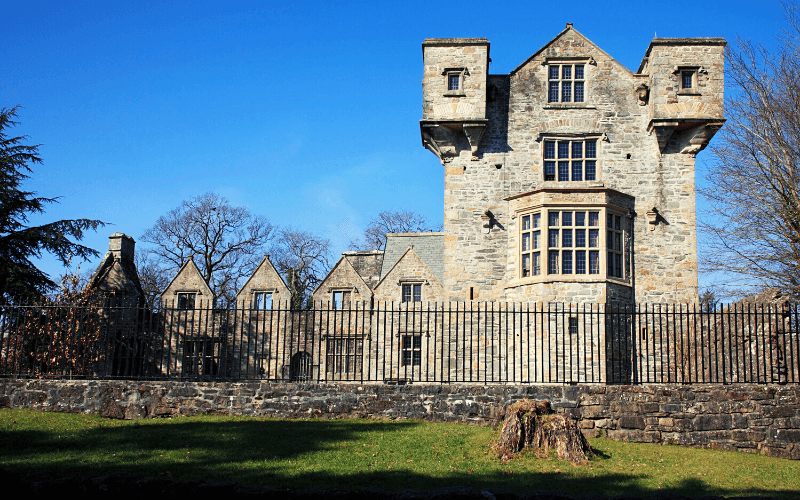
History: Donegal Castle, also known as O’Donnell Castle, is located in Donegal Town, County Donegal, Ireland. The castle was built in the 15th century by the powerful O’Donnell clan, who ruled the Kingdom of Tyrconnell for centuries. In the 17th century, the castle was captured by the English during the Nine Years’ War, and it subsequently fell into ruin. In the early 20th century, the castle was partially restored by the Irish Office of Public Works, and further restoration work was completed in the 1990s.
Features: Donegal Castle is a unique blend of both Irish and English architectural styles. The original 15th-century tower house, built by the O’Donnells, still stands and features distinctive Irish design elements such as the crenellated parapet and the large, intricately carved fireplace. The adjoining Jacobean-style manor house, built by English Captain Basil Brooke in the 17th century, displays a more English influence, with its elegant mullioned windows and decorative plasterwork. Visitors to the castle can explore the restored rooms, including the Great Hall, which is adorned with 17th-century furnishings and tapestries.
Legends: The O’Donnell clan, who built and inhabited Donegal Castle, was known for their fierce warrior spirit and were regarded as the Kings of Tyrconnell. It is said that the castle’s construction was guided by the clan’s chieftain, Red Hugh O’Donnell, who was a renowned and feared leader in his time. The castle is also believed to be haunted by the ghost of a Spanish soldier, who was part of the Spanish Armada and sought refuge in the castle after his ship was wrecked off the Irish coast.
Significance: Donegal Castle is an important historical and architectural landmark in County Donegal, reflecting the region’s rich and turbulent history. The castle is closely associated with the O’Donnell clan, who played a significant role in Irish history as rulers of the Kingdom of Tyrconnell. Today, the castle is open to the public, allowing visitors to explore the beautifully restored rooms and learn about the fascinating history of the O’Donnells and the broader historical context of the region.
20. Glenveagh Castle (Donegal)
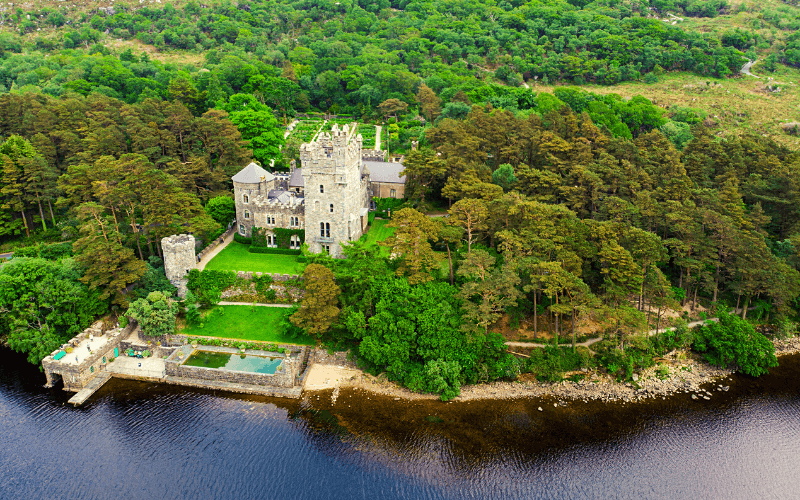
History: Glenveagh Castle is a stunning 19th-century castellated mansion nestled within the sprawling Glenveagh National Park in County Donegal, Ireland. The castle was built between 1870 and 1873 by John George Adair, a wealthy Irish-American businessman, who purchased a large tract of land in Donegal with the intention of creating an idyllic hunting estate. After Adair’s death, the castle and estate changed hands several times, with each owner adding their unique touch to the property. In 1983, the estate was donated to the Irish State and became part of Glenveagh National Park.
Features: Glenveagh Castle is an impressive example of Victorian architecture, designed in the Scottish Baronial style. The castle boasts four round towers, a stunning courtyard, and a granite exterior, making it an imposing sight amidst the rugged Donegal landscape. The interior of the castle is opulently decorated, with lavish furnishings, ornate plasterwork, and exquisite wood carvings. The castle is surrounded by beautifully landscaped gardens, which include a walled garden, a pleasure garden, and the expansive Glenveagh National Park, offering visitors a chance to explore the stunning natural beauty of the area.
Legends: Glenveagh Castle has its share of legends and folklore, including tales of the infamous John George Adair, who is said to have evicted his tenants to create his dream hunting estate. Many of the evicted tenants were forced to emigrate to America, and some locals believe that their spirits still haunt the castle and its grounds. Additionally, there are stories of a mysterious white lady who roams the castle gardens, believed to be the ghost of a woman who drowned in the nearby lake.
Significance: Glenveagh Castle is an important historical and architectural gem in County Donegal, showcasing the grandeur of the Victorian era in Ireland. The castle and its surrounding gardens and parkland offer visitors a glimpse into the lifestyle of the wealthy landowners of the time. As part of Glenveagh National Park, the castle also serves as a gateway to the breathtaking natural beauty of the area, with its rugged mountains, pristine lakes, and diverse flora and fauna. Today, the castle is open to the public, and visitors can enjoy guided tours, exploring the sumptuous rooms and learning about the fascinating history of the estate.
21. Slane Castle (Meath)
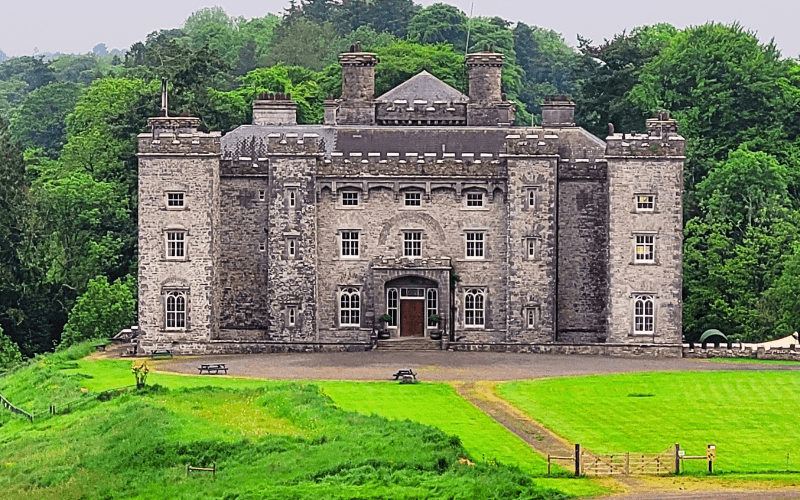
History: Slane Castle, situated in the heart of the Boyne Valley in County Meath, Ireland, dates back to the 18th century. The castle was built in 1785 by William Burton Conyngham and designed by the renowned architect James Gandon. Over the centuries, Slane Castle has been home to the Conyngham family, who still own and reside in the castle today. The castle’s rich history includes connections with St. Patrick, as it is said that he lit the Paschal Fire on the nearby Hill of Slane in 433 AD, defying the pagan High King of Tara.
Features: Slane Castle is a prime example of Gothic Revival architecture, with its imposing facade, crenelated towers, and a distinctive Gothic-style great hall. The interior of the castle is equally impressive, with elegant staterooms, intricate plasterwork, and a vast collection of art and antiques. The castle is surrounded by 1,500 acres of lush parkland, featuring walled gardens, woodlands, and a picturesque stretch of the River Boyne.
Legends: Slane Castle has a long history of legends and folklore associated with St. Patrick and the Hill of Slane. It is said that St. Patrick used the Hill of Slane as a vantage point to challenge the pagan High King of Tara by lighting the Paschal Fire, symbolizing the arrival of Christianity in Ireland. According to local legend, the High King was so impressed by St. Patrick’s bravery that he allowed the saint to continue spreading the Christian faith throughout the country.
Significance: Slane Castle holds great historical and cultural significance in Ireland, particularly due to its connections with St. Patrick and the early days of Christianity. The castle has also played host to some of the most iconic names in music, including U2, The Rolling Stones, and David Bowie, as it has been a famous concert venue since the 1980s. Slane Castle now operates as a luxury event venue and offers guided tours, giving visitors the opportunity to explore its rich history, architecture, and unique place in Irish culture.
22. Birr Castle (Offaly)
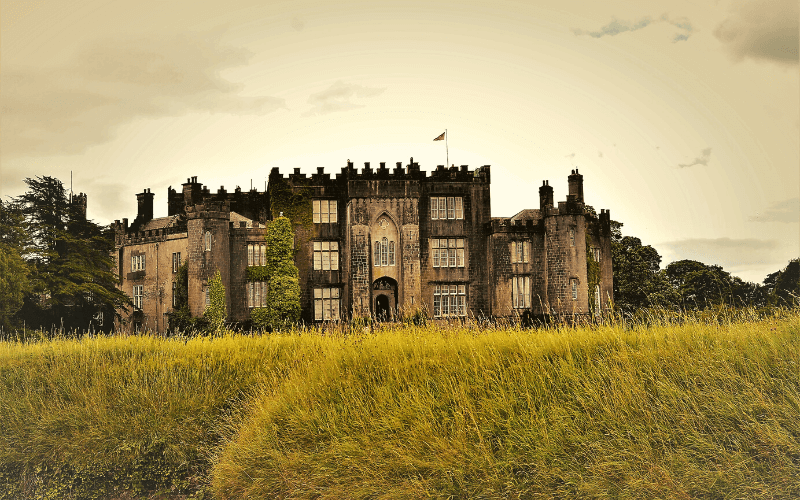
History: Birr Castle, located in County Offaly, Ireland, has a history dating back to the early 17th century. The castle was originally built by Sir Laurence Parsons in 1620, and his descendants, the Parsons family, still own and reside in the castle today. The castle has been renovated and extended several times over the centuries, reflecting the various architectural styles of those periods. Birr Castle is perhaps best known for its connection to science and astronomy, as the 3rd Earl of Rosse, William Parsons, built the “Leviathan of Parsonstown,” the world’s largest telescope, on the castle grounds in the 1840s.
Features: Birr Castle is an impressive example of Irish castle architecture, with a mix of architectural styles, including Gothic and Georgian influences. The castle’s interior boasts beautiful staterooms, a library, and a grand staircase, while the exterior is surrounded by extensive gardens and parklands. The castle grounds are home to the historic Great Telescope, which was the largest in the world for over 70 years and is still functional today. The grounds also feature the award-winning Science Centre, showcasing the history of astronomy, photography, and engineering at Birr.
Legends: While there are no specific legends associated with Birr Castle itself, the castle and its grounds have long been a source of fascination and inspiration due to their connection with scientific discoveries and innovation. The Great Telescope, in particular, has been a symbol of human ingenuity and the pursuit of knowledge for generations.
Significance: Birr Castle holds an important place in the history of science and innovation in Ireland and worldwide. The Great Telescope and the discoveries made by the 3rd Earl of Rosse and his family have contributed significantly to our understanding of the cosmos. Today, the castle and its grounds are open to the public, offering a unique opportunity to explore the rich history of the castle, its beautiful gardens, and its lasting scientific legacy.
23. Dunguaire Castle (Galway)
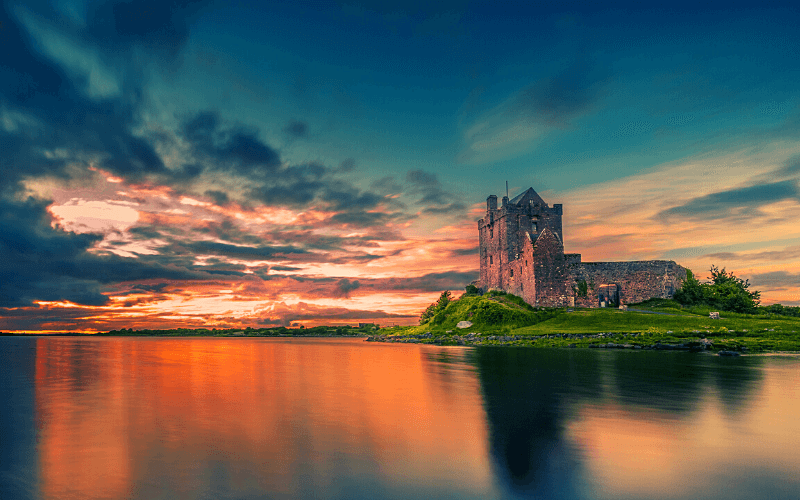
History: Dunguaire Castle, situated on the southeastern shore of Galway Bay, was built in the early 16th century by the Hynes clan. The castle changed hands several times throughout its history, with notable owners including the O’Shaughnessy and Martyn families. Today, it is considered one of the most famous and well-preserved castles in Ireland.
Features: The castle boasts a 75-foot-tall tower house with defensive walls and a small inner courtyard. Its architecture is typical of the Irish tower houses from the period. The castle has been restored over the years, maintaining its historical charm while providing modern amenities for visitors.
Legends: One of the legends surrounding Dunguaire Castle involves the Irish poet W.B. Yeats, who is said to have spent time at the castle during the early 20th century. It is believed that the castle’s mystical atmosphere inspired some of his works. Additionally, some tales tell of the castle being haunted by spirits from its past, including the ghost of a woman who died there under tragic circumstances.
Significance: Dunguaire Castle holds a significant place in Irish history and culture. It served as an important stronghold during its time and has been associated with several influential Irish families. The castle’s picturesque location overlooking Galway Bay and its association with Irish literature and folklore make it an enduring symbol of Ireland’s rich cultural heritage.
24. Rock of Dunamase (Laois)
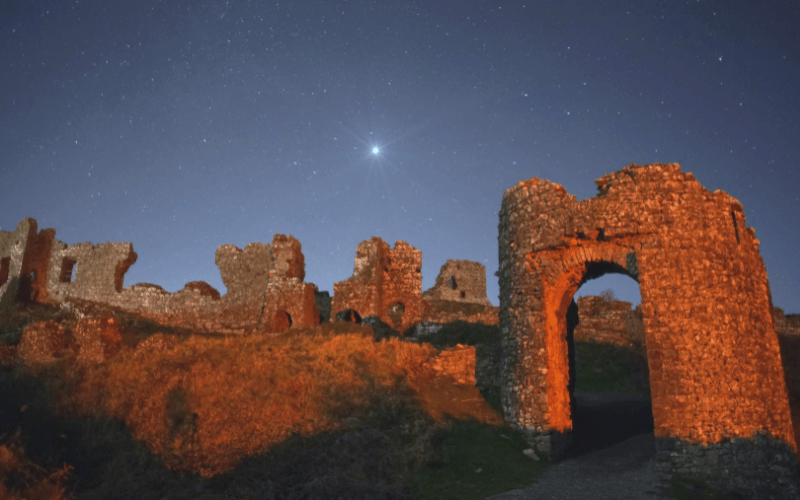
History: The Rock of Dunamase, located in County Laois, is an ancient fortress with a history dating back to the 9th century. The fortress was initially built by the Vikings and later came under the control of the O’Moore clan. In the 12th century, it was given to Strongbow, an Anglo-Norman nobleman, as a dowry when he married the daughter of the King of Leinster. The castle was eventually abandoned and fell into ruin by the 14th century.
Features: The ruins of the Rock of Dunamase stand on a rocky outcrop, offering breathtaking views of the surrounding countryside. The fortress was once surrounded by a curtain wall, and the remains of the gatehouse, barbican, and the main hall can still be seen today. The site’s strategic location and natural defenses made it an important stronghold in its time.
Legends: The Rock of Dunamase is steeped in legend and folklore. One such story tells of the treasure hidden by the O’Moore clan within the castle’s walls, which has yet to be discovered. Another tale involves a fairy enchantress who placed a curse on the castle, causing its abandonment and eventual decay.
Significance: The Rock of Dunamase is a remarkable historical site that bears witness to Ireland’s tumultuous past. It has a rich heritage, having been occupied by various factions throughout its history. Today, the ruins serve as a testament to the architectural prowess of its builders and offer visitors a fascinating glimpse into Ireland’s medieval history.
25. Classiebawn Castle (Sligo)
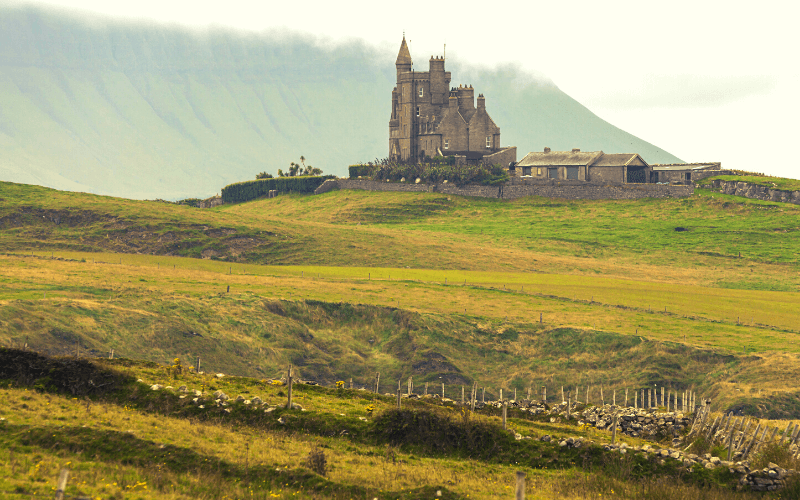
History: Classiebawn Castle, situated in County Sligo, is a Victorian-era country house built between 1871 and 1874 for the third Viscount Palmerston, a British statesman. After his death, the estate was inherited by the Mount Temple family, who owned it until the early 20th century. The castle was later purchased by Lord Mountbatten, a British naval officer and statesman, who used it as a summer residence until his assassination by the IRA in 1979. The estate is now privately owned.
Features: Classiebawn Castle is an imposing structure, with its distinctive Scottish Baronial architectural style. It features a tall central tower, turrets, and ornate stonework. The estate spans over 10,000 acres and includes beautifully landscaped gardens, woodlands, and breathtaking views of the Atlantic Ocean and Ben Bulben mountain. The castle is not open to the public, but visitors can admire its exterior and the surrounding landscape.
Legends: While there are no specific legends associated with Classiebawn Castle, its history is intertwined with that of the influential figures who once resided within its walls, such as Lord Palmerston and Lord Mountbatten. The castle’s connection to Lord Mountbatten has drawn interest from history enthusiasts and those interested in the turbulent period of Anglo-Irish relations.
Significance: Classiebawn Castle is a symbol of the grandeur and opulence of the Victorian era, showcasing the architectural style and craftsmanship of the time. The castle’s association with prominent historical figures, particularly Lord Mountbatten, adds to its significance as a site of interest in Ireland’s history.
26. Knappogue Castle (Clare)
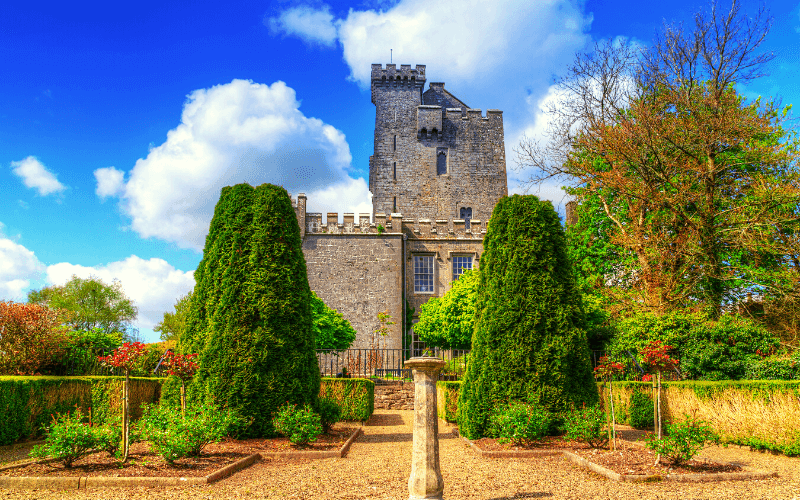
Knappogue Castle, located in County Clare, was built in 1467 by Sean MacNamara, a prominent Irish chieftain. The castle passed through various hands over the centuries, including the O’Brien and Scott families. In 1966, it was purchased by the Andrews family, who undertook an extensive restoration project. Today, the castle is owned by the Irish government and managed by Shannon Heritage.
Features: Knappogue Castle is a well-preserved example of a medieval tower house, with its rectangular structure and a fortified courtyard. The castle’s exterior boasts impressive stonework and battlements, while the interior is adorned with elegant furnishings and period decor. Visitors can explore the castle’s walled garden, which features a beautiful array of flowers and plants, as well as a charming rose garden.
Legends: One of the legends associated with Knappogue Castle is that of the “MacNamara Banshee.” The MacNamara family, original builders of the castle, were said to have a banshee who would appear and wail when a family member was about to die. This mysterious figure is said to continue haunting the castle to this day.
Significance: Knappogue Castle serves as an important example of medieval Irish architecture, showcasing the craftsmanship and defensive structures of the period. The castle also holds historical significance due to its connection to various influential Irish families and its continued preservation as a heritage site.
27. Doe Castle (Donegal)
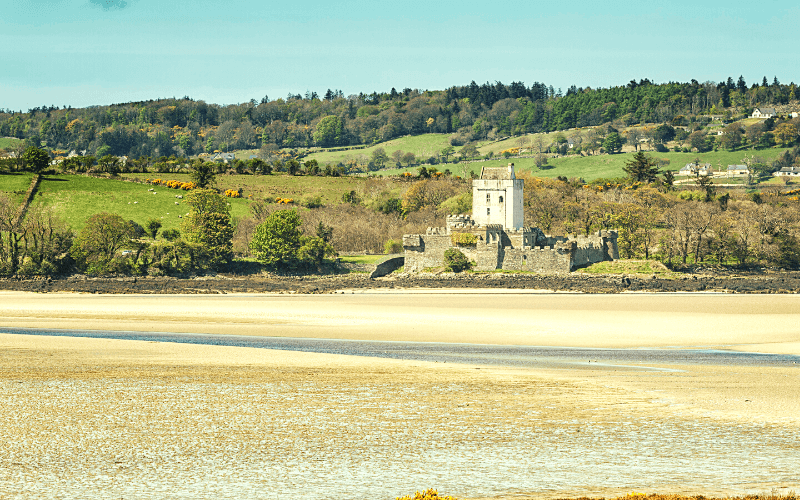
History: Doe Castle, situated on the picturesque Sheephaven Bay in County Donegal, dates back to the 15th century. The castle was constructed by the MacSweeney clan and served as their stronghold for several centuries. Throughout its history, the castle has witnessed numerous battles and changes of ownership. In the 17th century, it was captured by English forces during the Cromwellian conquest of Ireland. After changing hands multiple times, the castle is now under the care of the Office of Public Works.
Features: Doe Castle is a prime example of an Irish tower house, featuring a fortified rectangular keep surrounded by a protective curtain wall. The castle’s unique location on a small peninsula adds to its natural defenses, as it is almost completely surrounded by water. The castle’s outer walls and towers remain largely intact, allowing visitors to appreciate its imposing presence.
Legends: There are several legends associated with Doe Castle, including stories of hidden treasures and secret tunnels. One local tale tells of a secret tunnel that connected the castle to nearby Kildarragh, allowing the castle’s occupants to escape unseen during times of danger.
Significance: Doe Castle holds great historical significance as a stronghold of the MacSweeney clan, who played an essential role in the political landscape of the region. The castle’s impressive architecture and strategic location demonstrate the importance of defensive structures during the medieval period in Ireland. Today, the castle serves as a fascinating heritage site, allowing visitors to explore its storied past.
28. Dunlough Castle (Cork)
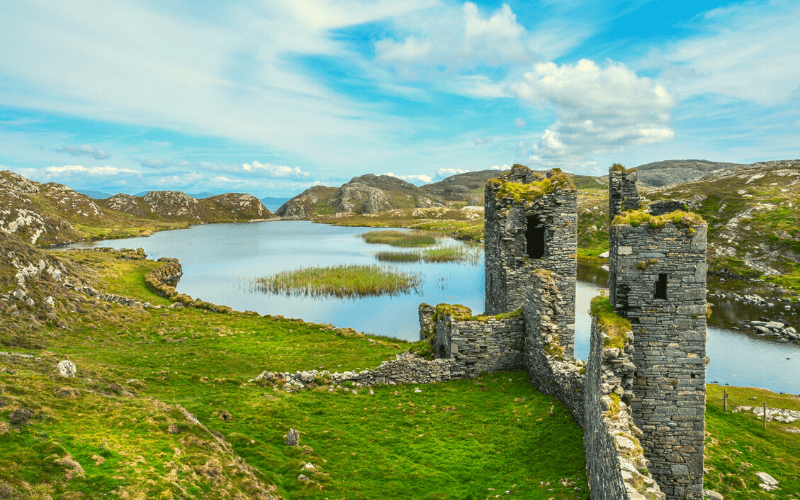
History: Dunlough Castle, also known as Three Castles Head, is a 13th-century castle located on the remote Mizen Peninsula in County Cork. The castle was built by the O’Mahony clan, a prominent Gaelic family in the region. The castle’s remote location and harsh weather conditions led to its eventual abandonment in the 17th century. Today, it stands as a testament to Ireland’s rich medieval history.
Features: Dunlough Castle consists of three fortified towers connected by a curtain wall, which is why it’s often referred to as Three Castles Head. The castle’s rugged stone architecture and the dramatic cliffside location overlooking the Atlantic Ocean make it an awe-inspiring sight. The castle’s remote setting and lack of modern development have allowed it to retain much of its original character and atmosphere.
Legends: Local legends and stories surround Dunlough Castle, including tales of smugglers and pirates using the isolated location as a hideout. It is said that in the 17th century, the notorious pirate queen Anne Bonny was born nearby, and the castle’s remote cliffs provided an ideal vantage point for observing passing ships.
Significance: Dunlough Castle is a significant example of medieval Irish architecture and the power dynamics of the time. Its remote location and haunting beauty make it a popular destination for historians, photographers, and visitors seeking a glimpse into Ireland’s past. The castle also offers a fascinating look at the challenges faced by the inhabitants of the region during the medieval period.
29. McDermott’s Castle (Roscommon)
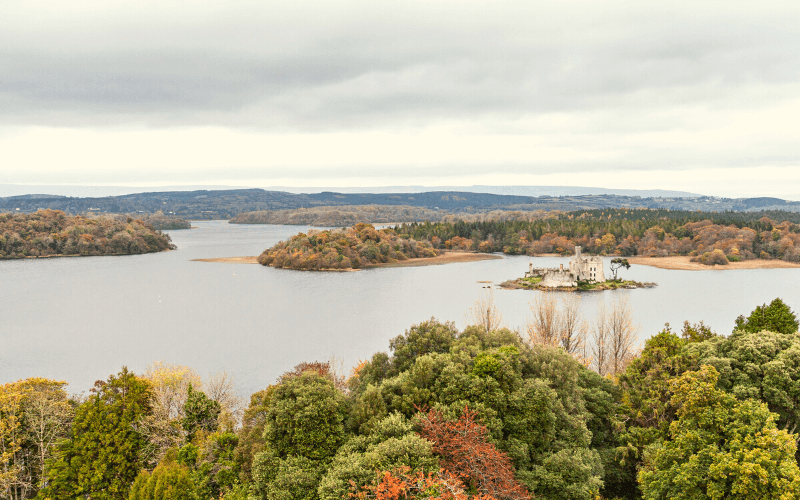
History: McDermott’s Castle, located on Castle Island in Lough Key, County Roscommon, was built in the 12th century by the McDermott Clan. The castle was later captured and destroyed by the English in the 17th century during the Cromwellian conquest.
Features: The ruins of the castle can be viewed from the shore of Lough Key, and boat trips to the island are available during the summer months. The surrounding Lough Key Forest Park offers beautiful walking trails and outdoor activities.
Legends: One of the legends associated with the castle tells of a beautiful princess named Una, who was cursed by an evil sorceress to sleep within the castle until her true love could awaken her with a kiss.
Significance: McDermott’s Castle is a historically significant site in County Roscommon, offering a unique insight into the region’s past and the power struggles between the Gaelic nobility and the English.
30. Cloughoughter Castle (Cavan)

History: Cloughoughter Castle is a 13th-century circular tower located on a small island in Lough Oughter, County Cavan. Built by the Anglo-Norman William Gorm de Lacy, the castle later became a stronghold for the O’Reilly clan, a prominent Irish family in the region. Over the centuries, the castle changed hands multiple times, witnessing battles and sieges. In the 17th century, during the Cromwellian conquest of Ireland, Cloughoughter Castle was heavily damaged and subsequently abandoned.
Features: The castle’s unique circular design and its location on a small island make it a striking and picturesque site. Surrounded by the tranquil waters of Lough Oughter, the castle is accessible only by boat. The tower’s thick walls and narrow windows provided protection and security for its inhabitants during turbulent times. The castle’s ruins still stand today, offering a glimpse into its storied past.
Legends: One local legend claims that a chieftain’s daughter fell in love with a young man from a rival clan. Forbidden to marry, the couple fled to Cloughoughter Castle for refuge. However, their love was doomed, as the chieftain’s forces attacked and recaptured the castle, killing the young lovers in the process. It is said that their spirits still haunt the castle, wandering the island and the surrounding waters.
Significance: Cloughoughter Castle holds historical significance as an example of Anglo-Norman architecture and the power struggles that characterized medieval Ireland. The castle’s isolated location and serene surroundings make it a popular destination for visitors interested in history, nature, and photography. The site is also an important habitat for a wide variety of bird species, attracting birdwatchers and wildlife enthusiasts.
Guided Tour: A guided tour of Cloughoughter Castle offers an engaging and informative experience, exploring the castle’s history, architecture, and legends. Knowledgeable tour guides lead visitors on a boat trip to the island, sharing stories of the castle’s past and the turbulent times it witnessed. The tour also highlights the natural beauty of Lough Oughter and the surrounding landscape, showcasing the rich biodiversity of the area.
31. Adare Castle (Limerick)
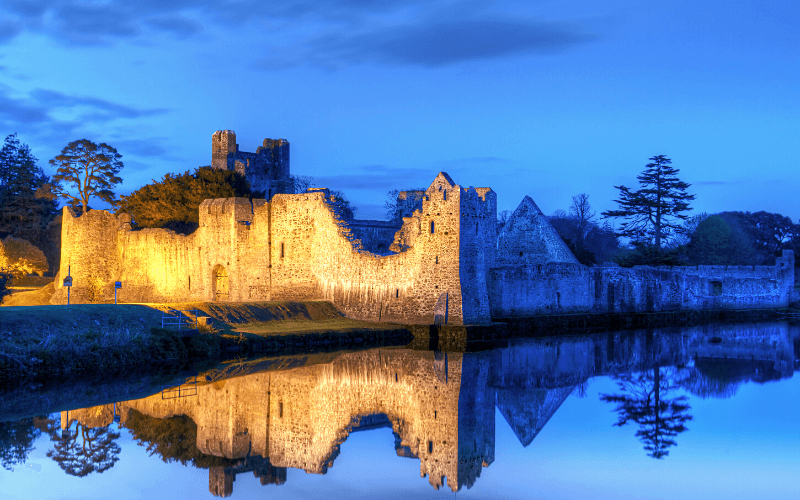
History: Adare Castle, also known as Desmond Castle or Adare Manor, is a historic castle situated in the picturesque village of Adare in County Limerick, Ireland. The original structure dates back to the 13th century and was built by the Kildare branch of the Fitzgerald family, the Earls of Desmond. Over the years, the castle underwent several reconstructions and expansions. In the 19th century, the castle was transformed into Adare Manor, a grand Gothic Revival mansion by the 2nd Earl of Dunraven.
Features: Adare Castle boasts a mix of architectural styles due to its various periods of construction. The original castle remains are visible, with the 13th-century tower house and parts of the defensive walls still standing. Adare Manor, the Gothic Revival mansion, features stunning craftsmanship, including ornate stonework, wood carvings, and stained-glass windows. The surrounding parkland and gardens add to the estate’s charm and beauty.
Legends: Local legends attribute the castle’s creation to a love story. It is said that the Earl of Desmond fell in love with a beautiful woman named Máire Rua. The Earl built Adare Castle to win her heart and make her his wife. The couple lived happily in the castle, and their descendants continued to reside there for generations.
Significance: Adare Castle represents the rich history of Ireland’s noble families and showcases a unique blend of architectural styles spanning centuries. Today, Adare Manor has been converted into a luxury hotel and golf resort, offering visitors a taste of the opulence and grandeur of the past. The castle’s picturesque location in the charming village of Adare makes it a popular destination for tourists seeking a blend of history, natural beauty, and modern luxury.
32. Minard Castle (Kerry)
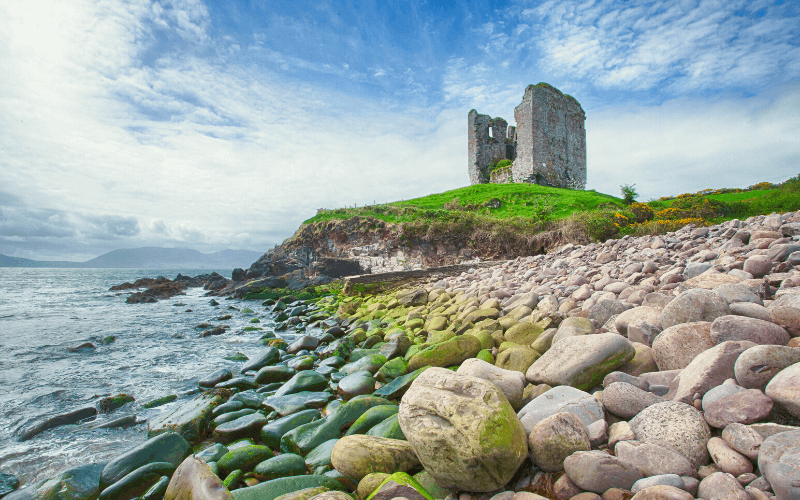
History: Minard Castle, located on the Dingle Peninsula in County Kerry, was built in the 16th century by the FitzGerald Clan. The castle was destroyed by the English during the Cromwellian conquest and has remained in ruins ever since.
Features: The castle is set on a dramatic cliff overlooking the Atlantic Ocean, with stunning views of the surrounding landscape. The nearby Minard Beach is a popular spot for swimming and picnicking.
Legends: It is said that the ghost of a FitzGerald chieftain, who was killed defending the castle from English invaders, still wanders the ruins, seeking revenge for his untimely death.
Significance: Minard Castle is a historically significant site in County Kerry, offering a unique insight into the region’s turbulent past and the impact of the English conquest on the Gaelic nobility.
33. Doonagore Castle (Clare)
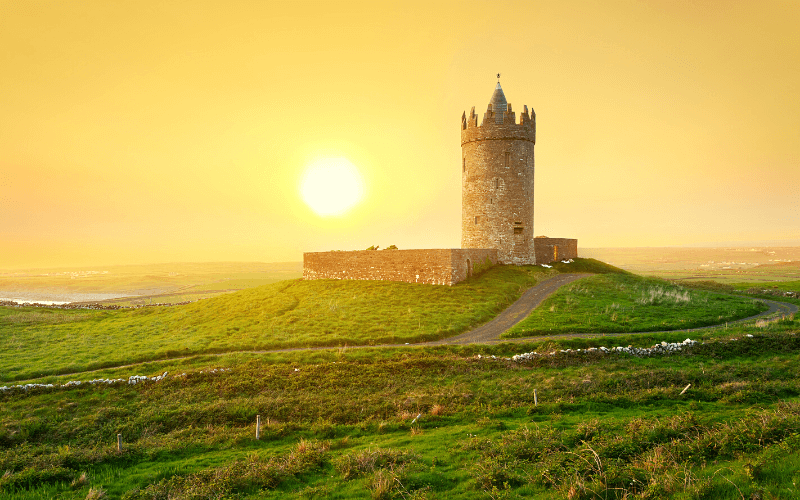
History: Doonagore Castle, located in County Clare, is a 16th-century tower house built by the O’Brien Clan. The castle was restored in the 1970s and is now a private residence.
Features: The castle is perched on a hill overlooking the village of Doolin and the Atlantic Ocean, offering stunning views of the Cliffs of Moher and the Aran Islands. The castle is not open to the public but can be viewed from the outside.
Legends: According to local lore, a shipwrecked crew from the Spanish Armada sought refuge at the castle but were captured and hanged by the castle’s owner.
Significance: Doonagore Castle is a well-preserved example of a 16th-century tower house and serves as a landmark for the picturesque village of Doolin and its surrounding coastal landscape.
34. Kinbane Castle (Antrim)
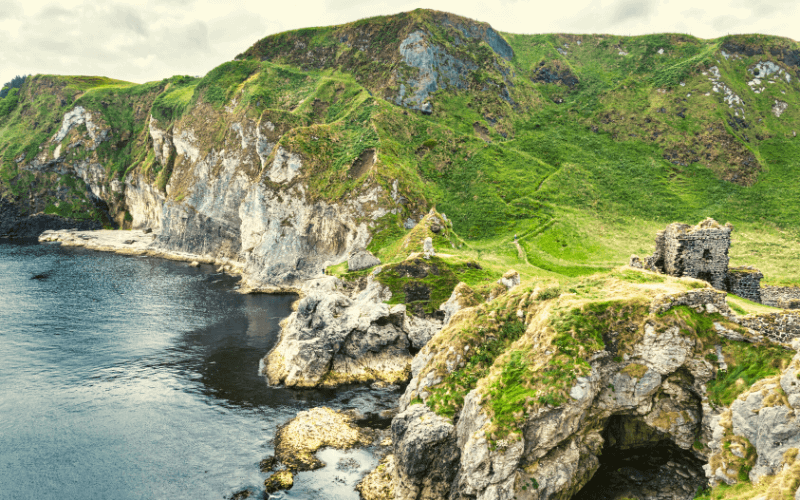
History: Kinbane Castle, situated on a rocky headland in County Antrim, Northern Ireland, was built in the 16th century by Colla MacDonnell, a chieftain of the MacDonnell Clan. The castle was destroyed and rebuilt several times during its history due to conflicts with the English.
Features: The castle’s ruins offer stunning views of the surrounding coastline, including Rathlin Island and the Scottish Isles in the distance. A narrow path leads visitors down the cliffside to the castle, making for a dramatic approach.
Legends: Some say that the ghost of Colla MacDonnell still roams the ruins of Kinbane Castle, protecting the land from any would-be invaders.
Significance: Kinbane Castle is an important historical site in County Antrim, showcasing the region’s medieval history and the power struggles between the Gaelic nobility and the English.
35. Blackrock Castle (Cork)
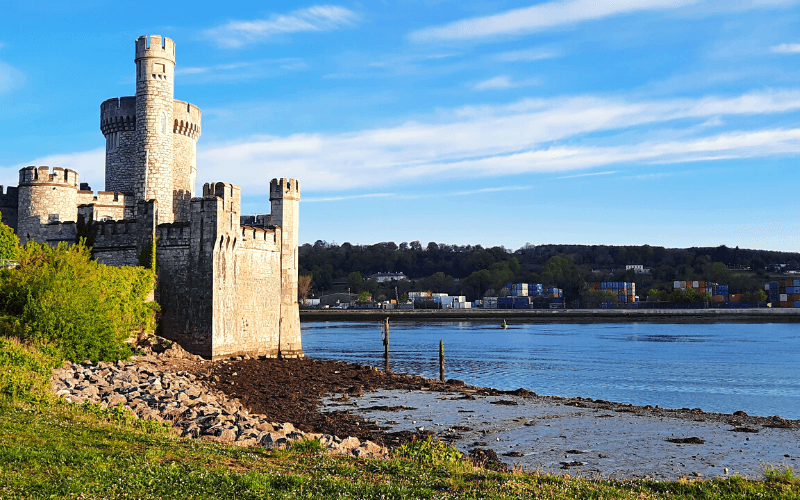
History: Blackrock Castle, located on the banks of the River Lee in County Cork, was originally built in the 16th century as a coastal defense fortification. The castle was destroyed and rebuilt several times throughout its history, most recently being restored in the 19th century.
Features: The castle now houses an interactive astronomy center and observatory, offering visitors a unique combination of history and science. The castle’s tower provides panoramic views of the River Lee and the surrounding area.
Legends: Local folklore tells of a mermaid who once lived in a cave beneath the castle, granting wishes to those who could capture her.
Significance: Blackrock Castle is a unique site in County Cork, blending historical significance with modern science and education.
36. Kilkenny Castle (Kilkenny)
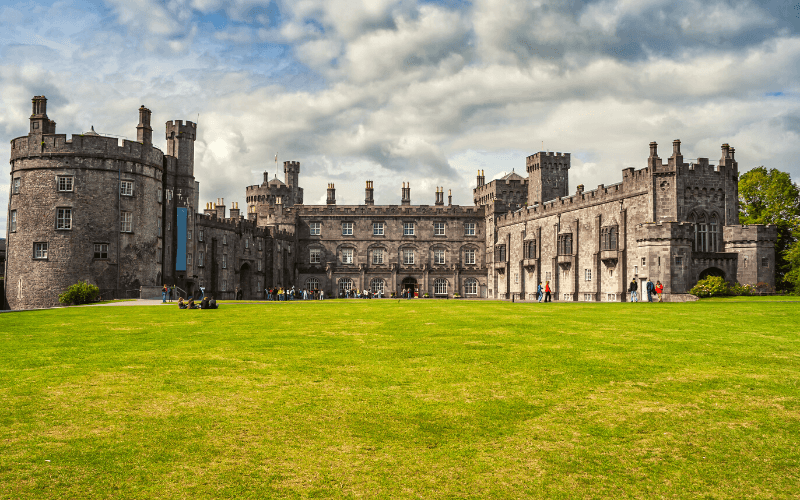
History: Kilkenny Castle, located in the heart of Kilkenny city, was built in the early 13th century by the Anglo-Norman magnate, William Marshal. Over the centuries, the castle has been home to some of Ireland’s most prominent families, such as the Butlers of Ormonde. Kilkenny Castle played a significant role in Irish history, particularly during the Confederate Wars and the Williamite War in the 17th century. In 1967, the 6th Marquess of Ormonde gifted the castle to the people of Kilkenny, and it has since become a popular tourist destination.
Features: Kilkenny Castle features a unique blend of architectural styles, including Norman, Gothic, and Victorian. The castle has been extensively restored and refurbished throughout its history, with various additions and renovations reflecting the changing tastes of its inhabitants. The castle’s most notable features include its stunning Picture Gallery, adorned with 17th-century tapestries and paintings, the ornate State Rooms, and the impressive Long Gallery. The castle is also surrounded by picturesque parklands and gardens, which offer a serene setting for leisurely walks and picnics.
Legends: While Kilkenny Castle does not have specific legends attached to it, the city of Kilkenny is steeped in history and folklore. One of the more famous legends in the area involves Dame Alice Kyteler, a wealthy 14th-century businesswoman who was accused of witchcraft. Kyteler managed to flee the country, but her servant, Petronilla de Meath, was not so fortunate and became the first person in Ireland to be executed for witchcraft.
Significance: Kilkenny Castle is an important symbol of Ireland’s rich historical past and the country’s architectural heritage. The castle has borne witness to numerous critical events in Irish history, and its magnificent interiors and artworks provide insight into the lifestyle of Ireland’s nobility throughout the centuries. Today, Kilkenny Castle is not only a popular tourist attraction but also a vibrant cultural center, hosting various art exhibitions, concerts, and events throughout the year.
37. Lough Eske Castle (Donegal)
History: Lough Eske Castle, situated in County Donegal, dates back to the 15th century and was originally the stronghold of the O’Donnell Clan. The castle has been extensively renovated and now operates as a luxury hotel.
Features: The castle is set on a picturesque lakeside estate, offering stunning views of Lough Eske and the surrounding woodland. The hotel features beautifully restored historical interiors, providing a luxurious experience for guests.
Legends: Some say that the spirits of the O’Donnell chieftains who once ruled the castle still roam the grounds, ensuring the continued prosperity of their ancestral home.
Significance: Lough Eske Castle is an important historical site in County Donegal, offering visitors the opportunity to experience the grandeur of the Gaelic nobility firsthand.
38. Glin Castle (Limerick)
History: Glin Castle, located in County Limerick, was the ancestral home of the FitzGerald family, hereditary Knights of Glin. The current castle was built in the 18th century, replacing an earlier medieval structure.
Features: The castle is situated on a picturesque estate overlooking the Shannon Estuary. Its interiors are adorned with historically significant artwork and furnishings, offering visitors a glimpse into the lives of Irish nobility.
Legends: Local legends claim that a secret tunnel exists beneath Glin Castle, connecting it to the nearby town of Glin.
Significance: Glin Castle is an important historical site in County Limerick, showcasing the architectural and cultural heritage of the FitzGerald family and the region.
39. Dromoland Castle (Clare)
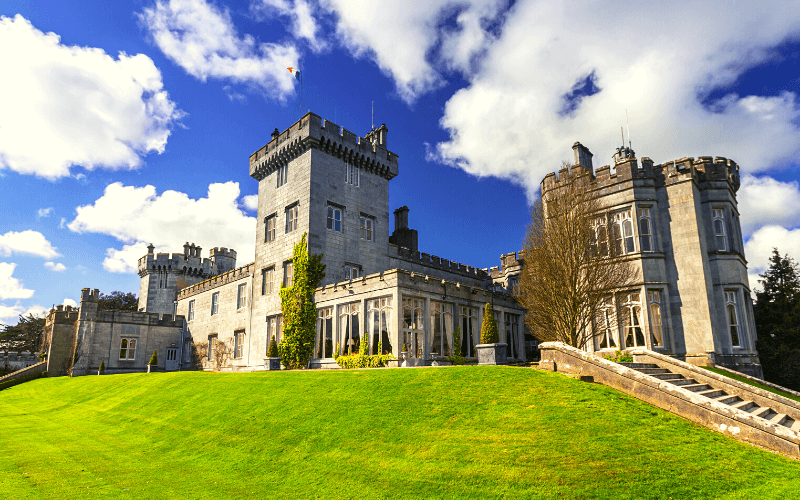
History: Dromoland Castle is a magnificent castle situated in County Clare, Ireland. The castle’s history dates back to the 16th century when it was the ancestral home of the O’Brien family, who were direct descendants of the High King of Ireland, Brian Boru. Over the centuries, the castle changed hands several times and underwent significant renovations. In the 1960s, it was transformed into a luxury hotel, preserving its historic charm while providing modern amenities.
Features: Dromoland Castle showcases impressive architectural features, including a combination of Gothic Revival and Queen Anne styles. The exterior boasts magnificent stonework, large bay windows, and ornate battlements. The interior features sumptuous furnishings, elegant wood paneling, and intricate plasterwork. The castle is surrounded by 450 acres of lush parkland, offering picturesque views of the Irish countryside.
Legends: Local legends say that the spirits of the O’Brien family still roam the castle’s halls. Guests and staff have reported hearing mysterious footsteps and experiencing other unexplained phenomena, such as doors closing on their own. These tales have only added to the allure of Dromoland Castle, making it a popular destination for visitors interested in history and the supernatural.
Significance: Dromoland Castle is an essential piece of Irish history, representing the power and influence of the O’Brien family and their connection to the High King of Ireland. Today, the castle serves as a luxury hotel, offering guests a unique opportunity to experience the grandeur and elegance of a bygone era. Its beautiful setting and rich history make it a popular destination for weddings, conferences, and special events.
Guided Tour: Guided tours of Dromoland Castle provide visitors with an in-depth look at the castle’s history, architecture, and legends. Knowledgeable guides lead guests through the castle’s stately rooms, sharing stories about the O’Brien family and the transformation of the castle into a luxury hotel. Visitors can also explore the castle’s extensive grounds, which include manicured gardens, a tranquil lake, and an 18-hole golf course.
Accommodation at Dromoland Castle offers guests a luxurious and comfortable stay, featuring 97 elegantly designed rooms and suites that blend historic charm with modern amenities. From stately castle rooms to the exclusive Presidential Suite, there is an option to suit every traveler’s needs. Guests can enjoy a range of amenities, including plush bedding, Wi-Fi, and spectacular views of the castle grounds and surrounding countryside.
40. Ballynahinch Castle (Galway)
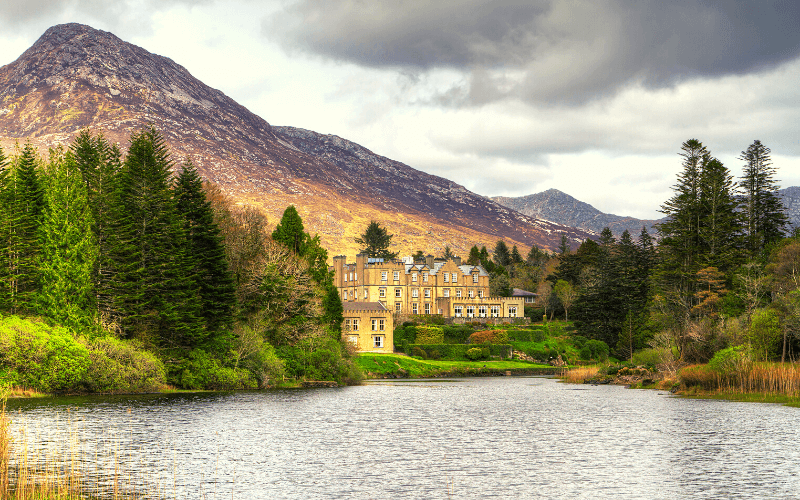
History: Ballynahinch Castle, nestled in the heart of Connemara, County Galway, has a rich and storied history dating back to the 18th century. The castle was originally built as a hunting lodge for the O’Flaherty clan and was later occupied by the Martin family, who were considered “Kings of Connemara.” In the 20th century, the castle was purchased by the renowned Irish poet and playwright Oliver St. John Gogarty before finally being transformed into a luxury hotel in the 1940s.
Features: Set on a 700-acre estate with beautiful woodland, rivers, and lakes, Ballynahinch Castle boasts stunning views of the surrounding countryside and the Twelve Bens mountain range. The castle offers a mix of traditional and contemporary architecture, with original features such as exposed stone walls and open fireplaces. The estate also features outdoor activities such as fishing, clay shooting, and walking trails.
Legends: One of the most famous legends associated with Ballynahinch Castle is the ghost of Grace O’Malley, the Pirate Queen of Connacht, who was married to Donal O’Flaherty, the original owner of the estate. It is said that her spirit still roams the castle’s corridors and can occasionally be spotted near the river bank.
Significance: Ballynahinch Castle is an important historic and cultural landmark in the region, showcasing the fascinating history of the Connemara area. Its stunning location and luxury amenities make it an ideal destination for visitors looking to explore the beauty of the Irish countryside while enjoying a touch of elegance and comfort.
41. Bective Abbey (Meath)
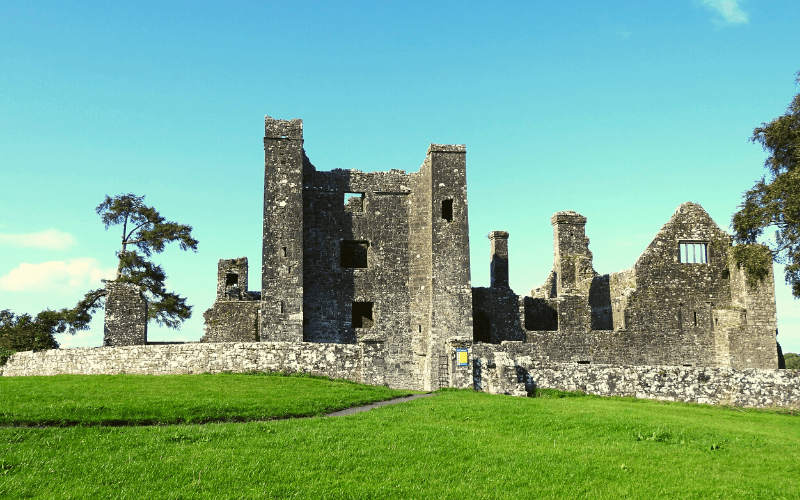
History: Bective Abbey, located in County Meath, was founded in 1147 as a Cistercian monastery. The abbey was dissolved in the 16th century during the Dissolution of the Monasteries by Henry VIII.
Features: The ruins of Bective Abbey are open to the public, offering visitors a glimpse into Ireland’s monastic past. The site includes the remains of a church, cloister, and several other monastic buildings.
Legends: There are no specific legends associated with Bective Abbey, but the site’s long history and connection to Ireland’s religious past create a sense of mystery and intrigue.
Significance: Bective Abbey is significant for its role in Ireland’s religious history and as an example of Cistercian architecture.
42. Ballysaggartmore Towers (Waterford)
History: Ballysaggartmore Towers are located in County Waterford, Ireland. These Gothic-style follies were constructed in the 19th century by Arthur Keily-Ussher, a wealthy local landlord, as part of his grandiose vision for a vast estate. Unfortunately, due to financial issues, the main house was never built, and the towers now stand as a testament to the ambitions and extravagance of the time.
Features: The Ballysaggartmore Towers consist of two distinctive structures: the Gate Lodge and the Bridge Lodge. Both lodges showcase impressive Gothic architecture, featuring pointed arches, intricate carvings, and crenelated parapets. The Gate Lodge marks the entrance to the estate, while the Bridge Lodge spans a small river, creating a picturesque scene. The towers are set amidst a vast woodland area, offering a serene and tranquil setting.
Legends: Local legends surrounding Ballysaggartmore Towers often focus on the eccentricities of the estate’s owner, Arthur Keily-Ussher, and his extravagant plans for the estate. Some stories even suggest that the towers were cursed due to the suffering of the local tenants during the construction.
Significance: Ballysaggartmore Towers hold historical significance as an example of 19th-century Gothic Revival architecture and as a symbol of the aspirations and excesses of the Irish gentry during this period. Today, the towers and their surrounding grounds are open to the public as part of Ballysaggartmore Demesne, offering visitors a chance to experience a unique piece of Irish history and enjoy the beauty of the woodland landscape.
43. Castle Leslie (Monaghan)
History: Castle Leslie is a stunning estate located in County Monaghan, Ireland. The castle’s history dates back to the 1660s when it was granted to the Leslie family by King Charles II. Over the years, the estate has seen several changes and expansions, with each generation of the Leslie family contributing to its development. Today, Castle Leslie remains in the hands of the family and operates as a luxury hotel, providing guests with a unique and authentic Irish experience.
Features: Castle Leslie is an exquisite example of Scottish Baronial architecture, showcasing a blend of Victorian and Gothic styles. The exterior features striking stone walls, imposing turrets, and ornate carvings. The interior is richly decorated with period furniture, lavish textiles, and exquisite artwork. The estate spans over 1,000 acres of the lush Irish countryside, including woodlands, gardens, and lakes.
Legends: Castle Leslie is said to be home to a few friendly ghosts, including the spirit of Norman Leslie, a World War I hero whose portrait hangs in the castle. Guests and staff have reported sightings of ghostly figures, adding a sense of mystery and intrigue to the estate’s already rich history.
Significance: Castle Leslie holds a significant place in Irish history due to its long-standing connection with the Leslie family, who have played a crucial role in the region’s cultural and political development. Today, the castle serves as a luxury hotel and event venue, allowing guests to immerse themselves in Ireland’s past while enjoying modern comforts and amenities.
Accommodation: Castle Leslie offers guests a luxurious and unique stay, featuring a variety of beautifully appointed rooms and suites that blend historic charm with contemporary amenities. Guests can choose from elegant castle rooms, charming lodge rooms, or the exclusive Old Stable Mews for a more private experience. The estate provides a range of amenities, such as Wi-Fi, gourmet dining options, and various outdoor activities, including horseback riding and fishing.
44. Kilkishen Castle (Clare)
History: Kilkishen Castle, located in County Clare, was built in the early 19th century by the Vandeleur family, who were prominent landlords in the region.
Features: The castle is now in ruins, but the remains of the structure offer a glimpse into the architectural style and grandeur of the past. The surrounding grounds provide an opportunity for visitors to explore the area’s natural beauty.
Legends: There are no specific legends associated with Kilkishen Castle, but the site’s history and connection to the Vandeleur family add to its intrigue.
Significance: Kilkishen Castle is significant for its connection to the Vandeleur family and its role in showcasing the architectural heritage of County Clare.
45. Ballinalacken Castle (Clare)
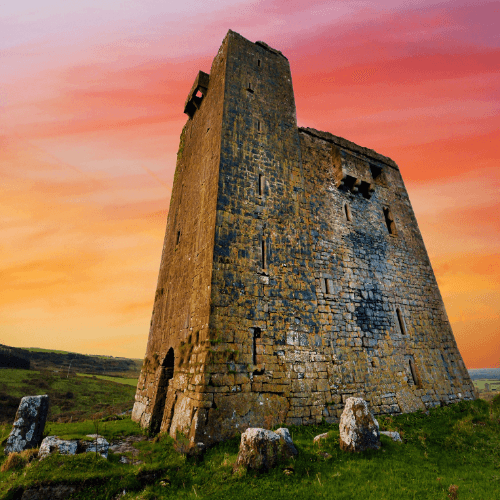
History: Ballinalacken Castle, located in County Clare, was originally built in the 15th century by the O’Brien family, descendants of the High King of Ireland, Brian Boru.
Features: The castle is now a boutique hotel, offering guests the opportunity to stay in a historic and unique setting. The surrounding landscape, with views of the Cliffs of Moher and the Aran Islands, adds to the charm of the location.
Legends: There are no specific legends associated with Ballinalacken Castle, but its connection to the O’Brien family and the High King of Ireland lends a sense of historical importance.
Significance: Ballinalacken Castle is significant for its connection to the O’Brien family and its role in preserving the history and cultural heritage of County Clare.
46. Aughnanure Castle (Galway)
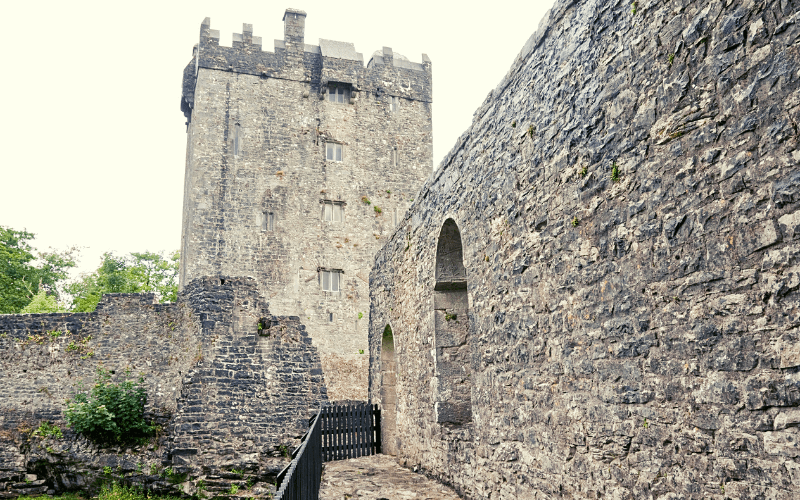
History: Aughnanure Castle, located in County Galway, was built in the 16th century by the O’Flaherty family, powerful Irish chieftains of the region.
Features: The castle is now managed by the Office of Public Works and is open to the public. Visitors can explore the well-preserved tower house, as well as the surrounding grounds, which include a bawn, a watchtower, and a mill.
Legends: There are no specific legends associated with Aughnanure Castle, but its history as the stronghold of the O’Flaherty chieftains adds to its intrigue.
Significance: Aughnanure Castle is significant for its connection to the O’Flaherty family and its role in showcasing the architectural heritage and history of County Galway.
47. Castle Ward (Down)
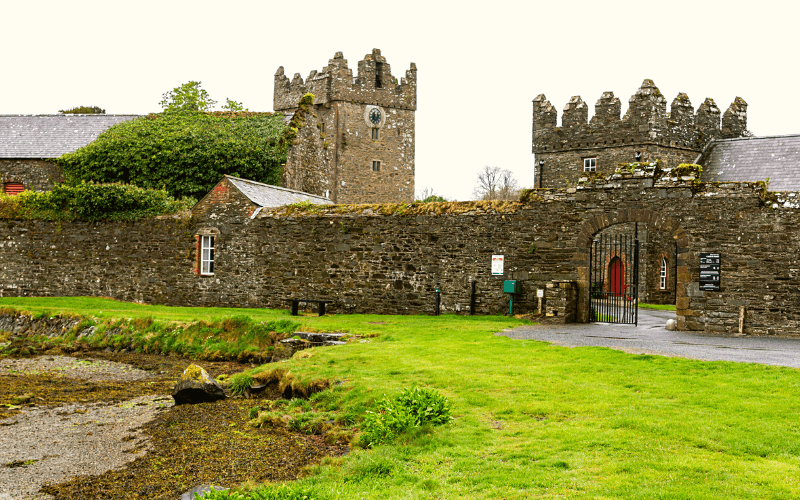
History: Castle Ward, located in County Down, Northern Ireland, was built in the 18th century by the Ward family. The castle is unique for its dual architectural styles, reflecting the differing tastes of the husband and wife who commissioned its construction.
Features: Castle Ward is now managed by the National Trust and is open to the public. The estate includes extensive gardens, walking trails, and even a small farm.
Legends: There are no specific legends associated with Castle Ward, but the unique architecture and history of the site create an air of mystery and fascination.
Significance: Castle Ward is significant for its unique architectural design and its role in preserving the history and cultural heritage of County Down.
Importance of Castles in Irish History and Culture
Castles played a crucial role in the history of Ireland, serving as both defensive fortresses and symbols of power and wealth for their occupants. These structures also played a significant part in Irish culture, often serving as centers for the arts, learning, and socializing. Many castles have been passed down through generations, with some families maintaining their ancestral homes for centuries.
Ireland is a treasure trove of castles, each with its own unique charm, history, and legends. With thousands of castles scattered throughout the country, it is nearly impossible to rank them or declare any one of them the best. However, the 47 castles featured in this article are truly remarkable and significant for various reasons. They showcase the rich history, breathtaking landscapes, and fascinating stories that make Ireland a must-visit destination for any traveler. So whether you’re a history buff, a nature enthusiast, or just someone looking to explore the enchanting beauty of Ireland, these castles offer a captivating glimpse into the past and the indomitable spirit of the Emerald Isle.
